All posts by Greg Reed
Mystery Fiction Writing Guide: Step-by-Step to Success

Most american readers crave stories that keep them guessing until the very last page. Crafting a mystery that stands out is no easy task, especially when more than 80 percent of manuscripts never make it past the first draft. Whether you are new to writing or fine-tuning your craft, understanding how to define a unique concept, shape intriguing characters, and layer suspenseful twists can transform your mystery into an unforgettable experience.
Table of Contents
- Step 1: Define Your Unique Mystery Concept
- Step 2: Develop Intriguing Characters And Motives
- Step 3: Structure Your Plot For Suspense And Pacing
- Step 4: Incorporate Clues, Twists, And Red Herrings
- Step 5: Polish And Review Your Finished Manuscript
Quick Summary
| Essential Insight | Clear Explanation |
|---|---|
| 1. Define a Unique Mystery Concept | Establish a fresh central question or crime that sets your story apart from typical narratives. |
| 2. Develop Intriguing Characters | Create multidimensional characters with complex motivations and personal stakes that drive the mystery forward. |
| 3. Structure for Suspense and Pacing | Build a plot with strategic pacing and plot points that maintain tension and engagement throughout the story. |
| 4. Incorporate Clues and Twists | Plant clues and red herrings that challenge readers while keeping them guessing about the true outcome. |
| 5. Polish and Review Your Manuscript | Conduct a thorough evaluation and seek feedback to ensure a polished, seamless narrative before finalizing your mystery. |
Step 1: Define your unique mystery concept
Creating a compelling mystery starts with developing a concept that sets your story apart from countless other narratives. According to ReadWriteThink, the foundation of an engaging mystery lies in carefully defining the central problem or puzzle that will drive your narrative.
To craft a unique mystery concept, begin by brainstorming an intriguing central question or crime that feels fresh and unexpected. Consider what makes your story different: perhaps an unusual setting, an unconventional protagonist, or a twist on traditional detective narratives. As ProgrammingLibrarian suggests, the key is developing an original storyline with compelling character motives that will keep readers guessing.
Your concept should include three critical elements: a central mystery that demands resolution, characters with complex motivations, and enough initial intrigue to hook your readers from the first page. Think about the unique perspective or angle you can bring to the mystery genre that will make readers lean in and say “I’ve never seen a story quite like this before.”
One practical tip: write down your core concept in a single sentence. If you can’t explain the essence of your mystery concisely, you might need to refine your idea further. This exercise will help you clarify the unique heart of your story and ensure your concept has the potential to sustain a full narrative.
Step 2: Develop intriguing characters and motives
Crafting compelling characters is the heartbeat of any memorable mystery narrative. Novlr suggests a powerful approach to character development by defining three critical elements: goal, motivation, and conflict. These components transform characters from mere placeholders into living breathing personalities that drive your story forward.
Start by creating multidimensional characters with complex internal landscapes. Your protagonist should have clear objectives that go beyond solving the mystery their personal desires and vulnerabilities must intersect with the central narrative. Consider crafting characters with hidden depths hidden agendas or conflicting motivations that make readers question their true intentions. What secrets might they be hiding? What personal stakes are embedded in their quest?
To build truly intriguing characters explore their backstories psychological triggers and emotional vulnerabilities. Each character should possess unique traits that make them unpredictable yet believable. Create characters with the potential for surprise who can unexpectedly shift the narrative trajectory. Think beyond stereotypical detective or victim archetypes and imagine characters whose motivations are nuanced and morally ambiguous.
One practical strategy is to write detailed character profiles that extend beyond surface level descriptions. Dive deep into their fears dreams and unresolved conflicts. Ask yourself what transformative experiences have shaped their worldview and how these experiences might influence their actions in your mystery. The most memorable characters are those who feel authentic complex and capable of surprising both the reader and themselves.

Step 3: Structure your plot for suspense and pacing
ReadWriteThink highlights the critical structure of a mystery story as a carefully orchestrated journey through problem introduction investigation and resolution. Crafting a compelling plot requires strategic pacing that keeps readers on the edge of their seats while revealing information at precisely the right moments.
To build suspense effectively begin by establishing a strong narrative framework with deliberate plot points that gradually unveil critical information. Your story should create a sense of constant tension where each chapter introduces new questions or unexpected twists. Understand the intricate role of suspense as more than just a storytelling technique it is the psychological thread that pulls readers deeper into your narrative.
According to Toledo Library creating a powerful hook is essential to maintaining reader engagement. This means your opening should immediately introduce a compelling mystery or conflict that demands resolution. Consider alternating between moments of high intensity and quieter reflective scenes to create a rhythmic narrative pulse that prevents reader fatigue.
One practical strategy is to map out your plot points like a series of carefully placed dominoes. Each revelation should trigger the next creating a cascade of suspense that propels the story forward. Pay attention to your story’s tempo some chapters might move quickly with rapid revelations while others build slow burning tension that allows psychological depth to emerge. The most memorable mysteries are those that balance external action with internal character transformation.
Step 4: Incorporate clues, twists, and red herrings
ReadWriteThink reveals that masterful mystery writing hinges on strategically planting clues and misdirections that challenge readers critical thinking skills. The art of creating an engaging mystery lies in carefully balancing information revelation with strategic deception.
Start by developing a complex web of potential suspects and motivations. Each clue should serve a dual purpose revealing something about the characters while simultaneously creating additional questions. Explore the nuanced world of psychological red herrings to understand how subtle narrative misdirections can keep readers guessing. Your goal is to create an intricate puzzle where every piece seems potentially significant yet ultimately misleading.
According to WritersLife, maintaining narrative urgency is crucial. This means your twists should feel both surprising and inevitable when revealed. Consider introducing clues that appear insignificant initially but become critically important later. The most compelling mysteries make readers feel simultaneously misled and enlightened when the truth emerges.
One practical strategy is to create a detailed timeline of your plot twists. Map out exactly when and how each clue will be introduced ensuring they build toward a satisfying yet unexpected resolution. Remember that great red herrings are not random distractions but carefully constructed narrative elements that reveal deeper psychological complexities within your characters and story.

Step 5: Polish and review your finished manuscript
ReadWriteThink provides a comprehensive Mystery Writing Rubric that serves as an essential roadmap for final manuscript evaluation. The process of polishing your mystery manuscript goes beyond simple proofreading it requires a strategic and methodical approach to ensuring every element of your story meets professional standards.
Begin with a comprehensive structural review. Evaluate your manuscript using a detailed checklist that examines plot consistency character development and narrative flow. Pay special attention to the resolution of your mystery plot. Does each clue connect logically? Are character motivations consistent? Are there any unresolved plot threads or unexplained narrative gaps that might confuse readers?
Consider engaging multiple perspectives during your review process. Seek feedback from beta readers who are familiar with the mystery genre and can provide objective insights. Some writers find it helpful to read the manuscript aloud or use text to speech software to catch awkward phrasing or dialogue that does not sound natural. Your goal is to create a manuscript that feels seamless polished and compelling from the first page to the final reveal.
One practical strategy is to create a separate editing document where you track potential revisions. This allows you to make notes without immediately altering your original manuscript. Remember that great mysteries are often refined through multiple rounds of careful editing. The difference between a good mystery and an exceptional one frequently lies in the meticulous attention to detail during the final polishing stages.
Elevate Your Mystery Writing with Real Examples and Inspiration
Struggling to build suspense or craft intricate plots that keep readers guessing The “Mystery Fiction Writing Guide Step-by-Step to Success” reveals how important it is to define unique concepts develop rich characters and master pacing. If you want to see these techniques in action explore our collections of mystery fiction short reads. Each story expertly weaves clues twists and psychological depth to inspire your own writing journey.
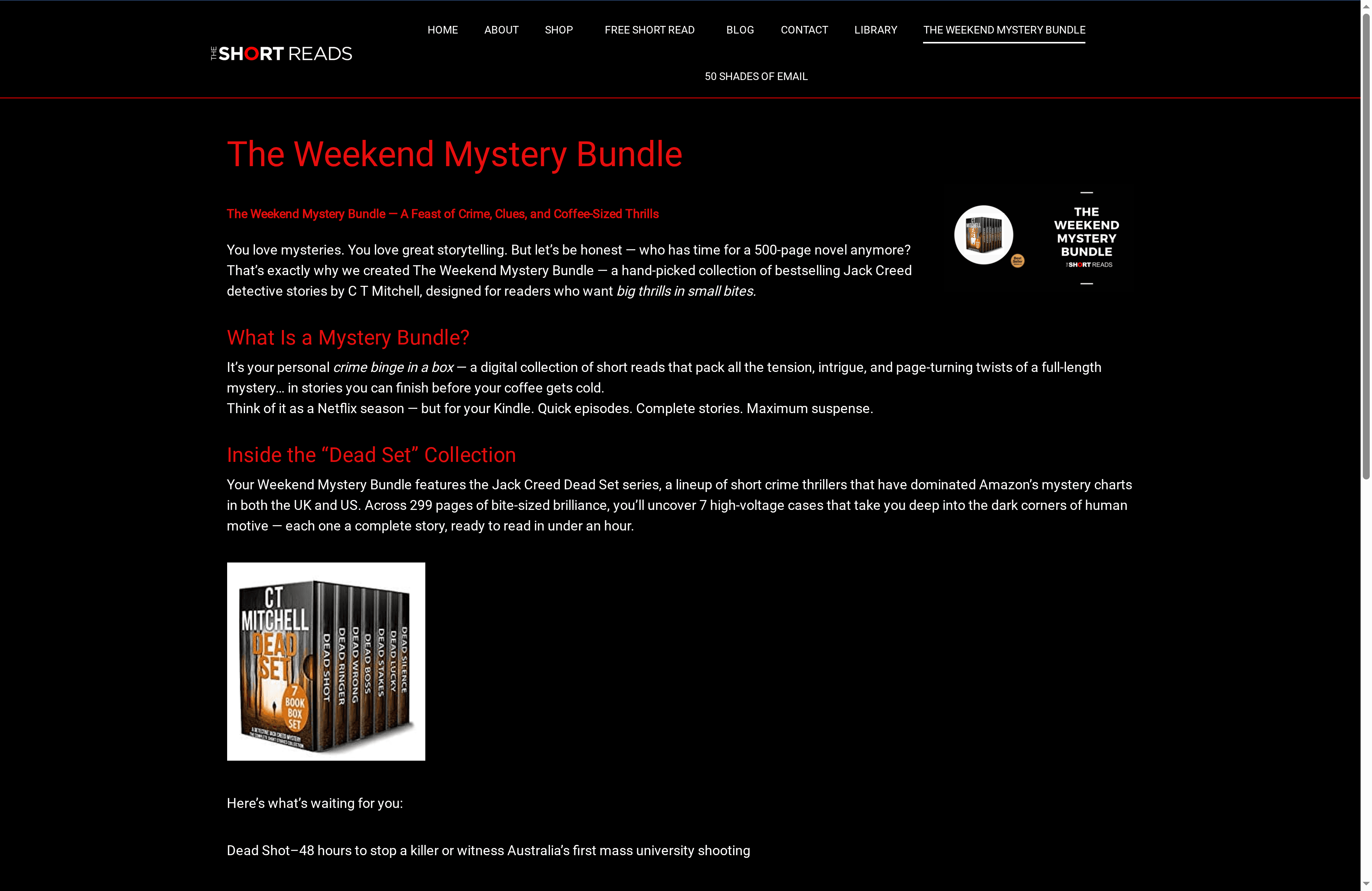
Unlock the power of immersive storytelling now and transform your ideas into captivating mysteries. Browse our The Weekend Mystery Bundle to get access to a variety of genres including cozy mysteries and detective short reads to spark creativity. Dive deep into professional-level suspense and character complexity by reading some of the best short reads available. Take the next step toward writing success today by visiting The Weekend Mystery Bundle and experience stories that set the standard for mystery fiction.
Frequently Asked Questions
How do I define a unique mystery concept for my story?
To define a unique mystery concept, brainstorm an intriguing central question or crime that feels fresh. Write your core concept in a single sentence to clarify and refine the essence of your story.
What should I include when developing my characters?
When developing characters, focus on their goals, motivations, and conflicts. Create detailed character profiles that explore their backstories and emotional vulnerabilities to make them multidimensional and compelling.
How can I structure my plot to maintain suspense?
Structure your plot by establishing a strong narrative framework with deliberate plot points that reveal critical information gradually. Map out your plot points like dominoes, ensuring each revelation triggers the next to keep readers engaged.
What strategies should I use for incorporating clues and red herrings?
Incorporate clues and red herrings by creating a complex web of potential suspects and motivations. Ensure each clue reveals something about the characters while also creating additional questions to challenge the reader.
How do I polish and review my finished manuscript?
To polish your manuscript, conduct a comprehensive structural review, focusing on plot consistency and character development. Use a detailed checklist and seek feedback from beta readers to capture any awkward phrasing or unresolved plot threads, refining your work until it feels seamless and compelling.
Recommended
- Short Mystery Writing Tips for Captivating Tales – TheShortReads.com
- Mystery Fiction Terminology: Complete Guide for Readers – TheShortReads.com
- Mystery Fiction – TheShortReads.com
- Understanding Mystery Fiction Terminology Explained – TheShortReads.com
Mystery Fiction Terminology: Complete Guide for Readers
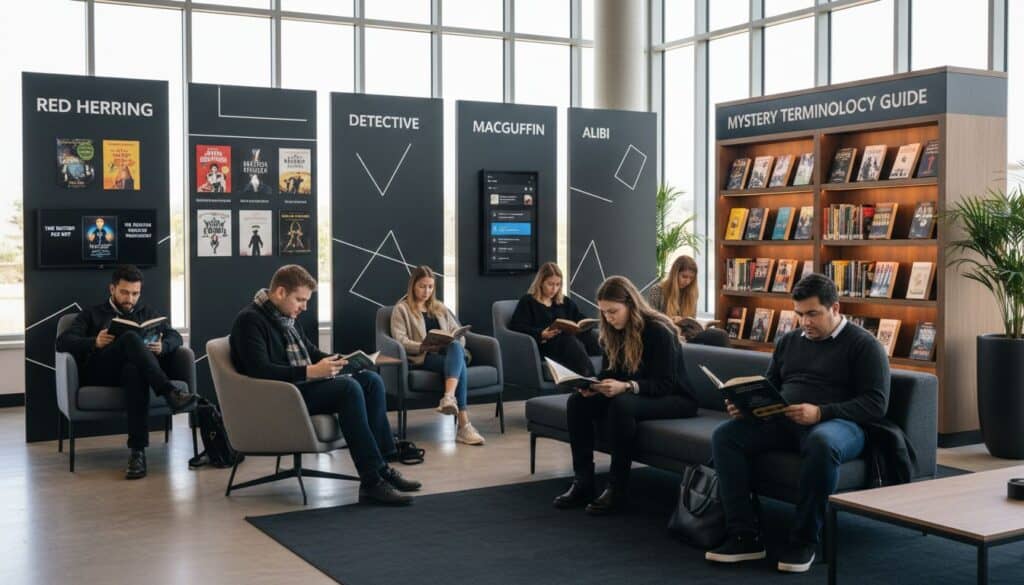
Over 80 percent of american readers find themselves puzzled by the unique language that fills mystery fiction stories. Understanding this specialized terminology matters because it shapes every twist, clue, and character you encounter in a detective novel. Whether you are a long-time fan or just starting to explore this genre, knowing these key terms brings every plot and clue into sharper focus. This guide unlocks the secrets behind the most important words in mystery fiction so every story becomes richer and more rewarding.
Table of Contents
- Mystery Fiction Terminology Defined Clearly
- Major Subgenres and Related Terminology
- Key Plot Devices and Character Archetypes
- Iconic Clues, Red Herrings, and Tropes
- Common Mistakes and Misused Terms
Key Takeaways
| Point | Details |
|---|---|
| Understanding Terminology | Mystery fiction has specific terminology such as detective, red herring, and MacGuffin that helps readers appreciate its complexity. |
| Subgenre Diversity | Major subgenres include detective fiction, cozy mystery, and true crime, each offering unique narrative styles and themes. |
| Character Archetypes | Common character types like the brilliant detective and the unreliable narrator enrich mystery storytelling by providing varied perspectives. |
| Common Misconceptions | Terminology in mystery fiction is often misused, making it essential for readers and scholars to understand the distinctions between subgenres. |
Mystery Fiction Terminology Defined Clearly
Mystery fiction is a captivating literary genre that transforms complex criminal puzzles into compelling narratives. According to Wikipedia, mystery fiction is characterized by an event, typically a crime, that remains enigmatic until the story’s conclusion, often involving a detective who unravels the mystery through logical reasoning.
Mystery fiction encompasses several distinctive terminology elements that help readers navigate and understand the intricate world of detective and crime narratives. These specialized terms provide insight into the genre’s narrative structures, character archetypes, and storytelling techniques.
Key terminology in mystery fiction includes several important categories:
- Detective: The primary investigator who systematically solves the central crime or puzzle
- Red Herring: A misleading clue intentionally designed to distract readers from the actual solution
- MacGuffin: An object or goal that drives the plot forward but may not have intrinsic significance
- Unreliable Narrator: A storyteller whose credibility is compromised, adding complexity to the narrative
For readers eager to explore more about the nuanced world of mystery storytelling, check out our guide on understanding mystery fiction terminology.
Major Subgenres and Related Terminology
Mystery fiction is a diverse literary landscape with multiple compelling subgenres. According to Wikipedia, major subgenres include detective fiction, true crime, cozy mystery, and locked-room mystery, each presenting unique narrative approaches and specialized terminology.
Detective Fiction represents the classic investigative narrative where a protagonist systematically uncovers criminal mysteries. This subgenre typically features a central investigator who uses logic, deduction, and keen observation to solve complex cases. Characters in detective fiction often follow specific archetypes: the brilliant lone detective, the methodical police investigator, or the amateur sleuth with extraordinary perception.
Other significant mystery subgenres include:
- Cozy Mystery: Gentle narratives set in small communities, featuring amateur detectives and minimal graphic violence
- Locked-Room Mystery: Intricate puzzles where a crime occurs in an apparently impossible scenario
- True Crime: Narratives based on actual criminal events, blending journalistic reporting with storytelling techniques
- Police Procedural: Stories focusing on systematic law enforcement investigation methods
As noted by LibGuides, mystery fiction subgenres are distinguished by unique themes and narrative styles, offering readers diverse approaches to exploring criminal intrigue.
IMAGE:descriptive_key_1] For readers interested in diving deeper into mystery storytelling, our [guide on understanding mystery fiction terminology provides comprehensive insights.
Key Plot Devices and Character Archetypes
Mystery fiction relies on intricate plot devices and memorable character archetypes to engage readers and create compelling narratives. According to Wikipedia, classic mystery novels like those by Ellery Queen exemplify the ‘fair play’ mystery approach, where readers receive all critical clues alongside the detective, transforming the reading experience into an intellectual challenge.
Character archetypes form the backbone of mystery storytelling, each bringing unique perspectives and investigative approaches. The primary investigative characters typically include:
- The Brilliant Lone Detective: Highly intelligent, often eccentric, who solves cases through exceptional deductive reasoning
- The Methodical Police Investigator: Systematic, procedural, following strict investigative protocols
- The Amateur Sleuth: Typically an outsider with keen observational skills who stumbles into solving mysteries
- The Flawed Protagonist: A complex character with personal challenges that both hinder and enhance their investigative abilities
In an innovative narrative twist, Wikipedia highlights the inverted detective story or ‘howcatchem’ approach, where the perpetrator is revealed at the story’s beginning. This technique shifts focus from ‘whodunit’ to ‘how will they be caught,’ creating a unique psychological exploration of crime and detection.
For readers intrigued by the psychological underpinnings of mystery narratives, our guide on character psychology offers deeper insights into the complex world of fictional investigators and their motivations.
Iconic Clues, Red Herrings, and Tropes
Mystery fiction thrives on the intricate dance of clues, misdirections, and narrative conventions that keep readers guessing. According to Wikipedia, the genre skillfully employs red herrings and complex clues to mislead readers, creating suspense and engaging them in the detective’s challenging journey to uncover the truth.
Red herrings represent one of the most compelling narrative devices in mystery storytelling. These deliberately misleading clues are strategically placed to:
- Distract readers from the actual solution
- Create additional narrative tension
- Challenge the protagonist’s investigative process
- Maintain reader engagement through uncertainty
Traditional mystery tropes have evolved dramatically over time. Wikipedia highlights an innovative approach with inverted detective stories, which subvert conventional narrative expectations by presenting the crime and perpetrator upfront. This technique transforms the narrative from a ‘whodunit’ to a fascinating exploration of investigative methodology and psychological motivation.
Readers fascinated by the nuanced world of narrative misdirection can explore more about these intricate storytelling techniques in our guide on red herrings, which delves deeper into the art of crafting compelling mystery narratives.
Common Mistakes and Misused Terms
Mystery fiction terminology is a nuanced landscape where precise definitions matter significantly. According to ALA Journals, certain subgenres like cozy mysteries are frequently undervalued or misclassified, creating challenges in literary scholarship and reader understanding.
Some of the most common terminology mistakes in mystery fiction include:
- Hardboiled vs. Detective Fiction: Often incorrectly used interchangeably
- Cozy Mystery vs. Traditional Mystery: Frequently confused despite distinct characteristics
- Thriller vs. Mystery: Misunderstood as synonymous genres
- Police Procedural vs. Detective Fiction: Subtle but important distinctions often overlooked
Bodhi Journals highlights the critical need for precise definitions, especially in academic and literary contexts. The conflation of hardboiled and detective fiction represents a prime example of how imprecise terminology can muddy our understanding of literary genres. Readers and scholars alike must pay careful attention to the nuanced differences between seemingly similar mystery subgenres.

For readers seeking to deepen their understanding of these complex distinctions, our guide on subtle literary classifications offers comprehensive insights into the intricate world of mystery fiction terminology.
Unlock the Mystery with Engaging Short Reads Tailored for You
Struggling to keep track of mystery fiction terminology like red herrings, cozy mysteries, and inverted detective stories can make enjoying the genre frustrating. If you love diving into complex puzzles or crave captivating stories featuring amateur sleuths and brilliant detectives but find traditional novels too time-consuming, our collection of mystery fiction short reads is designed just for you. Experience thrilling narratives that respect your busy schedule while immersing you in the exact subgenres and archetypes you enjoy.

Discover the perfect blend of intrigue and clarity with our Weekend Mystery Bundle. Featuring a carefully curated selection of cozy mystery short reads, murder mystery novellas, and detective short reads, you will embrace your passion for mystery fiction without getting lost in confusing terms or overwhelming plots. Don’t wait to transform your reading experience. Explore our collection now at theShortReads.com and decode mysteries effortlessly.
Frequently Asked Questions
What is mystery fiction?
Mystery fiction is a literary genre that revolves around an enigmatic event, typically a crime, that remains unsolved until the story’s conclusion. It often features a detective who uses logical reasoning to unravel the mystery.
What are common terminology used in mystery fiction?
Key terms in mystery fiction include ‘detective’ (the investigator), ‘red herring’ (misleading clues), ‘MacGuffin’ (a plot-driving object), and ‘unreliable narrator’ (a storyteller with questionable credibility).
What are the major subgenres of mystery fiction?
Major subgenres of mystery fiction include detective fiction, cozy mystery, locked-room mystery, true crime, and police procedural, each offering unique storytelling styles and themes.
How do red herrings function in mystery storytelling?
Red herrings are deliberately misleading clues designed to distract readers from the actual solution. They create tension and engage readers by maintaining uncertainty about the outcome.
Recommended
- Understanding Mystery Fiction Terminology Explained – TheShortReads.com
- Mystery Fiction – TheShortReads.com
- Short Mystery Writing Tips for Captivating Tales – TheShortReads.com
- 7 Smart Ways to Discover Mystery Fiction for Men – TheShortReads.com
Psychological Thriller Explained: Key Elements and Types

Psychological thrillers grip us with more than nail-biting suspense. This genre pulls readers into the hidden corners of the mind, turning the ordinary into something far more unsettling. Studies show these stories are among the most popular in modern fiction, thanks to their focus on psychological tension and complex characters. If you want to understand what makes psychological thrillers so impactful, exploring their core elements and storytelling secrets opens a window into the thrill that keeps audiences hooked.
Table of Contents
- Defining Psychological Thrillers And Core Concepts
- Major Subtypes And Genre Variations
- Essential Storytelling Techniques Used
- Recurring Themes And Character Archetypes
- Common Pitfalls And What Readers Should Know
Key Takeaways
| Point | Details |
|---|---|
| Psychological Depth | Psychological thrillers focus on complex characters and their internal conflicts rather than external action. |
| Genre Variations | Subtypes like domestic noir and horror-of-personality offer unique insights into human psychology and narrative structure. |
| Narrative Techniques | Techniques such as unreliable narration and symbolic visual metaphors enhance the psychological experience for the audience. |
| Cautionary Elements | Readers should be aware of narrative clichés and representational challenges within the genre to fully appreciate its depth. |
Defining Psychological Thrillers and Core Concepts
Psychological thrillers represent a riveting genre that delves deep into the intricate labyrinths of human consciousness. According to en.wikipedia.org, these narratives combine elements of thriller and psychological fiction, focusing intensely on characters’ mental states, perceptions, and complex interpersonal dynamics.
At their core, psychological thrillers explore profound psychological landscapes that challenge traditional narrative boundaries. As research from ijnrd.org reveals, these stories immerse audiences in gripping narratives that expose characters’ deepest delusions, insecurities, and unresolved traumas. The genre masterfully blends elements of horror, mystery, and psychological investigation to create uniquely tension-filled experiences.
The key characteristics of psychological thrillers include:
- Intense psychological manipulation
- Exploration of unstable mental states
- Complex character motivations
- Blurred lines between reality and perception
- Deep investigations into human consciousness
Unlike traditional thriller genres, psychological thrillers prioritize internal conflict over external action. They transform the human mind into a battlefield, where characters wrestle with their own fears, secrets, and psychological demons. psychological motifs play a critical role in constructing these intricate narrative experiences, revealing how perception can become both a weapon and a vulnerability.
These narratives often challenge readers by presenting scenarios where nothing is as it initially appears. Mental instability, unreliable narrators, and psychological transformations become the primary storytelling mechanisms, creating an atmosphere of persistent uncertainty and psychological tension.
Major Subtypes and Genre Variations
Psychological thrillers encompass a rich and diverse landscape of narrative approaches, each subgenre offering unique insights into human psychology. According to en.wikipedia.org, the horror-of-personality subgenre represents a particularly intense exploration of psychological darkness, focusing on human villains with profoundly disturbing mental landscapes.
One compelling variation is domestic noir, which en.wikipedia.org describes as a subgenre centered on the dark undercurrents of intimate relationships. This approach transforms seemingly ordinary domestic settings into psychological minefields, revealing the complex emotional tensions lurking beneath surface normalcy.
The major subtypes of psychological thrillers include:
- Horror-of-Personality: Emphasizing psychological depth of human villains
- Domestic Noir: Exploring intimate relationship dynamics
- Paranoid Thrillers: Focusing on characters’ deepening sense of existential threat
- Cognitive Dissonance Narratives: Challenging characters’ perception of reality
- Trauma-Based Psychological Thrillers: Investigating unresolved psychological wounds
Each subtype approaches psychological tension through distinct narrative strategies. Paranoid thrillers, for instance, create suspense by gradually eroding characters’ sense of safety, while cognitive dissonance narratives deliberately destabilize audience expectations about narrative reality. psychological transformation becomes a critical lens through which these stories explore the fragility of human perception.
These genre variations share a fundamental commitment to excavating the complex interior worlds of characters. They transform psychological exploration into a high-stakes narrative adventure, where mental and emotional landscapes become more dangerous and unpredictable than any external threat.
![]()
Essential Storytelling Techniques Used
Psychological thrillers deploy a sophisticated arsenal of narrative techniques designed to penetrate the deepest recesses of human psychology. According to en.wikipedia.org, these narratives masterfully employ unreliable narrators and intricate plot twists to create a dissolving sense of reality that keeps audiences perpetually unsettled and emotionally invested.
Visual and atmospheric storytelling plays a crucial role in psychological thrillers. Research from ijnrd.org reveals how directors use symbolic elements like mirrors and strategic lighting techniques to externalize characters’ inner psychological landscapes. Low-key lighting and shadow play become powerful tools for portraying emotional turmoil, transforming visual aesthetics into a metaphorical representation of characters’ mental states.

The key storytelling techniques in psychological thrillers include:
- Unreliable Narration: Challenging audience perception
- Symbolic Visual Metaphors: Representing psychological states
- Non-Linear Narrative Structures: Disrupting chronological storytelling
- Psychological Fragmentation: Depicting mental breakdown
- Sensory Manipulation: Creating disorienting audience experiences
These narrative strategies work in concert to create a profoundly immersive psychological experience. By deliberately destabilizing traditional storytelling conventions, psychological thrillers transform narrative itself into a psychological exploration.
effective storytelling becomes a lens through which complex human experiences are examined and transformed.
Ultimately, the most powerful technique in psychological thrillers is their ability to blur boundaries between external reality and internal perception. They invite audiences to question not just what is happening, but how and why characters experience their reality in such uniquely fractured and compelling ways.
Recurring Themes and Character Archetypes
Psychological thrillers explore a complex tapestry of human experience through deeply nuanced themes and intricate character dynamics. According to en.wikipedia.org, these narratives frequently delve into profound psychological territories like death, identity, perception, and the malleable nature of reality, creating intense explorations of human consciousness.
The genre’s character archetypes are particularly fascinating. en.wikipedia.org highlights the emergence of characters like the femme fatale and the unreliable narrator, who challenge traditional storytelling by embodying psychological complexity. These characters often operate within intricate domestic landscapes, transforming seemingly ordinary relationships into psychological battlegrounds of manipulation and hidden motivations.
The most prevalent themes and character archetypes include:
- Themes:
- Psychological Disintegration
- Identity Crisis
- Manipulation and Betrayal
- Perception vs. Reality
- Moral Ambiguity
- Character Archetypes:
- The Obsessive Detective
- The Psychologically Fractured Protagonist
- The Manipulative Antagonist
- The Unreliable Witness
- The Psychological Predator
Unlike traditional narrative forms, psychological thrillers reject simplistic character representations. emotional storytelling becomes a critical lens through which these complex characters are examined, revealing the intricate psychological mechanisms that drive human behavior.
Ultimately, these themes and archetypes serve a profound purpose: they strip away social masks, exposing the raw, often uncomfortable truths about human nature. By presenting characters who exist in psychological gray areas, these narratives challenge audiences to confront the complexity of human motivation and the thin line between sanity and psychological breakdown.
Common Pitfalls and What Readers Should Know
Psychological thrillers, while compelling, are not immune to narrative traps that can undermine their psychological depth. According to en.wikipedia.org, the genre frequently struggles with predictable plot twists and overused narrative devices that can diminish the intellectual and emotional impact of the story.
Research from ijnrd.org highlights a critical concern about the genre’s representation, particularly the problematic perpetuation of stereotypes. The femme fatale archetype, for instance, often reinforces harmful narratives about women’s sexuality and psychological complexity, reducing nuanced characters to simplistic, potentially damaging tropes.
Key pitfalls readers should be aware of include:
- Narrative Weaknesses:
- Overly predictable plot structures
- Reliance on clichéd psychological tropes
- Shallow character development
- Unrealistic psychological representations
- Excessive reliance on shock value
- Representational Challenges:
- Stereotypical character archetypes
- Oversimplification of mental health experiences
- Sensationalization of psychological trauma
- Limited diversity in character perspectives
- Romanticization of dysfunctional behaviors
7 Essential Psychological Thriller Tips for Every Reader can help readers develop a more critical and nuanced approach to navigating these potential narrative pitfalls.
Ultimately, discerning readers should approach psychological thrillers with both intellectual curiosity and critical awareness. By recognizing these potential limitations, audiences can engage more deeply with the genre’s true potential: exploring the complex, often uncomfortable terrain of human psychological experience.
Dive Deeper Into Psychological Thrillers With Short Reads Designed to Engage Your Mind
If you find yourself captivated by the complex mental games and blurred realities described in psychological thrillers this is your chance to experience these elements firsthand. This genre’s challenges such as navigating unreliable narrators and exploring fractured perceptions can sometimes feel overwhelming but also intensely rewarding. Our collection of psychological thriller short reads offers sharp insights and engrossing stories that perfectly capture the essence of manipulation betrayal and identity crisis found in these narratives.

Explore our selection today by visiting The Weekend Mystery Bundle. With titles carefully crafted to highlight intricate character psychology and thrilling plot twists you’ll find the perfect balance between emotional storytelling and gripping suspense. Don’t wait to immerse yourself in stories that challenge your perception and keep you guessing. Your next engaging psychological thriller awaits now at The Weekend Mystery Bundle. Discover how short reads can transform your understanding of this captivating genre.
Frequently Asked Questions
What are the main characteristics of psychological thrillers?
Psychological thrillers are characterized by intense psychological manipulation, exploration of unstable mental states, complex character motivations, and blurred lines between reality and perception. They prioritize internal conflict, focusing on characters’ fears, secrets, and psychological demons.
What are the common subtypes of psychological thrillers?
The major subtypes include Horror-of-Personality, Domestic Noir, Paranoid Thrillers, Cognitive Dissonance Narratives, and Trauma-Based Psychological Thrillers. Each subtype explores psychological tension through unique narrative strategies.
What storytelling techniques are commonly used in psychological thrillers?
Key storytelling techniques in psychological thrillers include unreliable narration, symbolic visual metaphors, non-linear narrative structures, psychological fragmentation, and sensory manipulation. These techniques create an immersive and unsettling experience for the audience.
What are some recurring themes and character archetypes in psychological thrillers?
Recurring themes include psychological disintegration, identity crisis, manipulation and betrayal, perception vs. reality, and moral ambiguity. Common character archetypes feature the obsessive detective, psychologically fractured protagonist, manipulative antagonist, unreliable witness, and psychological predator.
ShareWhy Novellas Are Popular: Complete Reader Guide

Nearly every avid reader has discovered the sweet spot between short stories and lengthy novels, where novellas shine. These compact works pack the emotional punch and depth of full novels into a format that rarely exceeds 50,000 words. For time-pressed readers, novellas offer an immersive escape without the marathon commitment, making them more appealing than ever. This guide reveals what sets novellas apart, clears up common misconceptions, and spotlights why their unique structure captures global audiences.
Table of Contents
- Novellas Defined: Core Features And Myths
- Types Of Novellas In Mystery And Thriller
- How Novellas Fit Busy Modern Lifestyles
- Appeal To Diverse And Global Audiences
- Novellas Versus Novels And Short Stories
Key Takeaways
| Point | Details |
|---|---|
| Defining Characteristics | Novellas, distinct from novels and short stories, typically focus on a single conflict, feature condensed character development, and can be read in one sitting. |
| Popularity Growth | The increasing demand for immersive yet quick narratives makes novellas appealing to busy readers seeking convenience without compromising storytelling quality. |
| Genre Versatility | Mystery and thriller novellas encompass various subgenres, each providing unique storytelling experiences while maintaining fast-paced narratives. |
| Cultural Accessibility | Novellas allow for diverse themes and global perspectives, making them accessible to a broad audience through their concise format and universal appeal. |
Novellas Defined: Core Features And Myths
A novella occupies a unique literary space between short stories and full-length novels, offering readers a compact yet immersive narrative experience. According to Wikipedia, the term originates from the Italian word ‘novella’, meaning ‘new’, and represents a prose fiction form with distinct structural characteristics that set it apart from longer and shorter written works.
Novellas are characterized by several core features that distinguish them from traditional novels and short stories. As research from University of Babylon indicates, these narratives typically possess the following attributes:
- Focused Narrative: Concentrates on a single primary conflict or theme
- Condensed Character Development: Fewer characters compared to novels
- Compact Length: Designed to be read in one sitting
- Realistic Tone: Often satirical or grounded in realistic storytelling
- Minimal Chapter Structure: Generally lacks traditional chapter divisions
Contrary to common myths, novellas are not simply ‘shorter novels’ but sophisticated literary forms with their own narrative integrity. They require precise storytelling skills, demanding authors craft complex narratives within limited word counts.
 Writers must strategically develop characters, advance plot, and create meaningful narrative arcs without the expansive canvas of a full novel.
Writers must strategically develop characters, advance plot, and create meaningful narrative arcs without the expansive canvas of a full novel.
The popularity of novellas continues to grow, particularly among busy readers and those seeking immersive storytelling experiences that can be consumed quickly. Short Reads vs Novellas: Everything You Need to Know provides deeper insights into why these compact narratives have captured readers’ imaginations across various genres and reading preferences.
Types Of Novellas In Mystery And Thriller
Mystery and thriller novellas represent a dynamic and captivating literary genre that delivers intense storytelling within a compact narrative framework. According to MWEditing, these narratives are characterized by fast-paced plots, intriguing mysteries, and suspenseful twists that keep readers engaged through unexpected revelations and gripping storylines.
The mystery and thriller novella landscape encompasses several distinctive subgenres, each offering unique storytelling approaches:
- Hard-Boiled Mysteries: Urban settings with complex moral landscapes
- Cozy Mysteries: Lighthearted narratives with less graphic violence
- Psychological Thrillers: Deep explorations of character mental states
- Political Thriller Novellas: Intrigue centered around governmental or institutional conflicts
- Detective Short Reads: Compact investigations with focused narrative arcs
As MasterClass explains, each subgenre brings its own distinctive elements to the novella format. Hard-boiled mysteries often feature morally ambiguous urban landscapes, while cozy mysteries provide gentler, more lighthearted narrative experiences that appeal to readers seeking less intense storytelling.
For readers seeking immersive yet quick reading experiences, thriller novellas offer the perfect balance of suspense and concise storytelling. These compact narratives allow readers to experience complete, intricate stories without the time commitment of full-length novels, making them ideal for busy mystery enthusiasts who crave compelling narratives in bite-sized formats.
How Novellas Fit Busy Modern Lifestyles
In today’s fast-paced world, reading time is a precious commodity, and novellas have emerged as the perfect literary solution for time-strapped book lovers. According to MWEditing, these compact narratives cater specifically to readers with limited time by offering concise yet complete stories that can be consumed in a single sitting.
The unique advantages of novellas for busy individuals include:
- Quick Consumption: Complete stories readable in one sitting
- Minimal Time Investment: Shorter than traditional novels
- High-Intensity Narratives: Concentrated plot and character development
- Flexible Reading: Perfect for commutes, lunch breaks, or short leisure moments
- Storytelling Efficiency: Maximum narrative impact with minimum time commitment
Research from University of Babylon confirms that novellas are strategically designed to provide full narrative experiences without demanding extensive time investments. This makes them particularly attractive to professionals, students, and anyone struggling to balance reading with demanding schedules.
For those seeking practical reading strategies that align with modern lifestyle constraints, short reads benefits guide offers additional insights into maximizing literary enjoyment within limited timeframes. Novellas represent more than just shorter books – they’re a sophisticated reading approach tailored for contemporary readers who refuse to compromise on storytelling quality despite time limitations.
Appeal To Diverse And Global Audiences
Novellas represent a powerful literary form that transcends cultural boundaries, offering a unique storytelling experience that resonates with readers across different backgrounds and languages. According to MWEditing, the concise format allows authors to explore diverse themes and settings, making these compact narratives remarkably accessible to a global readership.
The universal appeal of novellas is rooted in several key characteristics that make them attractive to diverse audiences:
- Linguistic Accessibility: Easier translation due to shorter length
- Cultural Flexibility: Adaptable narratives that cross geographical boundaries
- Thematic Universality: Exploration of fundamental human experiences
- Economic Reading: Affordable and less time-consuming for international readers
- Genre Diversity: Wide range of storytelling styles and perspectives
Research from University of Babylon highlights the novella’s historical influence across European literary traditions, demonstrating its remarkable ability to create realistic narratives that resonate with diverse audiences. The compact format allows for nuanced storytelling that can bridge cultural differences while maintaining narrative intensity.
For readers seeking global perspectives, mystery novellas offer an exceptional window into different cultural experiences, providing rich storytelling without the significant time investment of full-length novels. This unique literary form continues to break down cultural barriers, offering readers a sophisticated yet accessible approach to understanding diverse human experiences.
Novellas Versus Novels And Short Stories
The literary landscape is rich with diverse narrative forms, each offering unique storytelling experiences. According to Wikipedia, novellas occupy a distinctive middle ground, characterized by a length that falls between short stories and full-length novels, creating a compelling format that captures readers’ imagination with remarkable precision.
Key differences between novellas, novels, and short stories include:
- Length: Novellas range from 30,000 to 50,000 words, compared to novels (over 50,000 words) and short stories (under 7,500 words)
- Narrative Complexity: More developed than short stories, less intricate than novels
- Character Development: Focused character arcs with limited but deep exploration
- Plot Structure: Single primary conflict versus multiple subplots in novels
- Reading Time: Typically completed in one sitting
Research from University of Babylon emphasizes that while novels generally extend beyond 200 pages with complex narrative structures, novellas offer a more concentrated storytelling experience. They provide readers with a complete narrative journey without the extensive time commitment required by full-length novels.
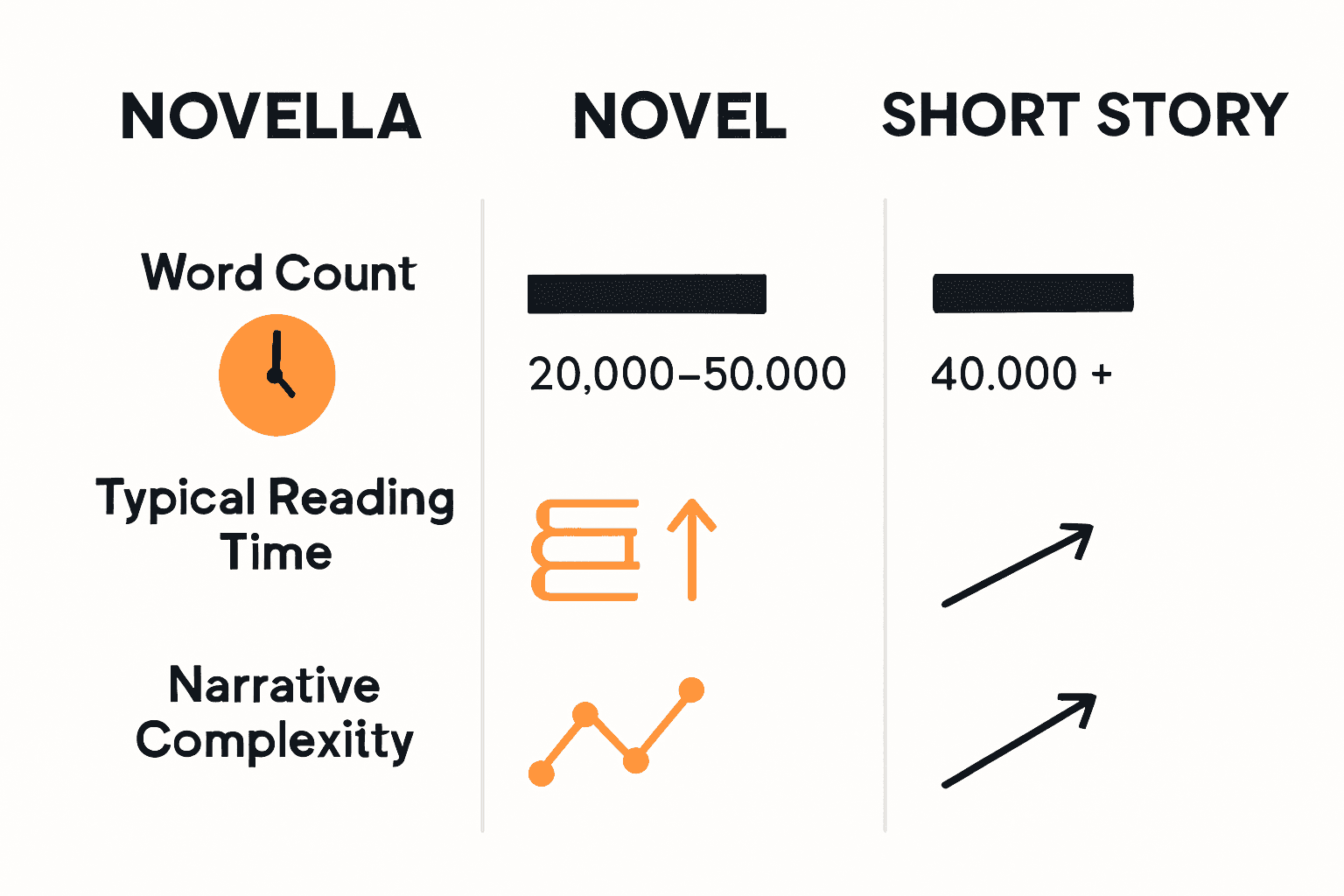
For readers seeking a deeper understanding of these literary distinctions, Novellas vs. Novels: Complete Guide to Key Differences offers comprehensive insights into the nuanced world of narrative formats. Novellas ultimately represent a sophisticated middle ground, delivering rich storytelling with exceptional narrative efficiency.
Discover Perfect Novellas That Fit Your Busy Life and Mystery Cravings
Finding time to enjoy a captivating story can be tough when life moves fast. This article highlights how novellas meet the challenge by offering quick yet immersive storytelling with focused narratives and intense plots. Whether you are drawn to cozy mysteries, psychological thrillers, or political intrigue, the compact format of novellas lets you experience rich characters and suspenseful twists without a huge time commitment.
Enjoy the emotional excitement of a complete story in one sitting by exploring our Weekend Mystery Bundle.

Dive into a collection curated for readers who value both quality and convenience. From cozy mystery short reads to murder mystery novellas, our selections bring you intense plotlines and carefully crafted characters ready to thrill and entertain. Start your novella journey now at The Short Reads and experience the perfect balance of suspense and brevity tailored for your lifestyle.
Frequently Asked Questions
What defines a novella compared to a novel and a short story?
A novella typically ranges from 30,000 to 50,000 words, offering a more developed narrative than a short story (under 7,500 words) but less complexity than a full-length novel (over 50,000 words). It focuses on a single conflict and allows for concentrated character development within a compact format.
Why are novellas appealing to busy readers?
Novellas are designed for quick reading, allowing busy individuals to complete a story in one sitting. Their concise narratives provide high-intensity storytelling with minimal time investment, making them ideal for readers looking to fit literature into hectic schedules.
What are the main themes explored in mystery and thriller novellas?
Mystery and thriller novellas often explore themes such as crime, morality, psychological tension, and political intrigue. They captivate readers with fast-paced plots, unexpected twists, and a focus on single primary conflicts that draw readers into the narrative.
How do novellas resonate with a global audience?
Novellas are linguistically and culturally accessible due to their shorter length, making them easier to translate and adapt across different cultural contexts. Their universal themes, such as fundamental human experiences, appeal to diverse audiences, allowing readers worldwide to engage with a variety of storytelling perspectives.
Recommended
- The Essential Guide to the Role of Novellas in Fiction – TheShortReads.com
- Novellas vs. Novels: Complete Guide to Key Differences – TheShortReads.com
- Short Reads vs Novellas: Everything You Need to Know – TheShortReads.com
Novellas vs. Novels: Complete Guide to Key Differences

A novella offers a unique middle ground in fiction, packing a punch with its concise storytelling. For many readers and writers, knowing whether a story is best told as a novella or a novel can shape the entire reading experience. With novels typically exceeding 50,000 words and novellas ranging from 20,000 to 40,000 words, these two forms provide distinct ways to explore characters and worlds. Understanding their differences helps you choose the right path for your next literary adventure.
Table of Contents
- Defining Novellas And Novels: Core Differences
- Length, Structure, And Narrative Scope
- Genre Trends In Novellas And Novels
- Audience Appeal And Reader Experiences
- Choosing Between Novellas And Novels
Key Takeaways
| Point | Details |
|---|---|
| Length and Complexity | Novellas range from 20,000 to 40,000 words, while novels start at 50,000 words, with the former focusing on a single theme and the latter allowing for intricate plots. |
| Genre Suitability | Novellas excel in concise genres like romance and mystery, whereas novels are suited for expansive explorations like epic fantasy and historical fiction. |
| Reading Experience | Novels deliver immersive storytelling appealing to deep character exploration, while novellas provide quick, impactful narratives ideal for busy readers. |
| Choosing Format | Select a novella for focused narratives and limited complexity, and a novel for multi-dimensional storytelling and extensive world-building. |
Defining Novellas and Novels: Core Differences
Understanding the fundamental differences between novellas and novels is crucial for readers and writers alike. According to research from naac.psou.ac.in, a novella is a prose fiction that sits uniquely between a short story and a novel, characterized by its focused narrative approach and limited scope.
Novella Characteristics
- Typically shorter than a traditional novel
- Concentrates on a single incident or core theme
- Features one or two primary characters
- Often set in a single location
- Can usually be read in one sitting
Novels, in contrast, provide a more expansive storytelling landscape. As detailed by uobabylon.edu.iq, novels are extensive narratives exceeding 40,000 words, enabling authors to craft intricate plots and develop complex character arcs. While novellas maintain a tightly focused narrative, novels allow writers to explore multiple storylines, introduce numerous characters, and delve deeper into thematic explorations.
Novel Characteristics
- Longer narrative format
- Supports complex, multi-layered plots
- Allows extensive character development
- Can include multiple subplots and perspectives
- Generally structured with distinct chapters
The primary distinguishing factor between novellas and novels lies in their narrative complexity and length. Short Reads vs Full Novels: Complete Guide offers additional insights into how these different formats serve unique storytelling purposes. Novellas provide a concentrated, intense reading experience, while novels offer a more immersive and expansive journey through fictional worlds.
Length, Structure, and Narrative Scope
The distinction between novellas and novels becomes most apparent when examining their length, structural complexity, and narrative scope. According to ballard-tighe.com, novels typically start at 50,000 words, offering substantial space for comprehensive storytelling, while novellas range from 20,000 to 40,000 words, providing a more concentrated narrative experience.
Word Count Breakdown
- Novels: 50,000+ words
- Novellas: 20,000 to 40,000 words
- Short Stories: Under 7,500 words
Research from spines.com highlights the fundamental difference in narrative approach. Novellas maintain a narrow focus, concentrating on a single central theme, character, or event, often avoiding the complexity of multiple subplots. Novels, conversely, offer expansive storytelling real estate, enabling writers to weave intricate narratives with multiple characters, rich settings, and interconnected storylines.
Structural Characteristics
- Novels support complex, multi-layered plots
- Novellas maintain a streamlined, focused narrative
- Novels can include extensive character backstories
- Novellas typically explore one primary character arc
For writers and readers seeking more insights into compact storytelling formats, Understanding Short Story Structure: A Deep Dive provides additional context about narrative design across different literary forms. The key takeaway is that while novels offer a panoramic view of a fictional world, novellas provide an intimate, concentrated exploration of a specific narrative moment or character experience.

Genre Trends in Novellas and Novels
Genre selection plays a critical role in determining whether a story is best suited as a novella or a full-length novel. According to aspiringwriteracademy.com, novellas excel in genres that benefit from concise, focused storytelling, such as romance, mystery, and suspense.
Ideal Genres for Novellas
- Romance
- Mystery
- Suspense
- Psychological thrillers
- Tight character studies
Research from inca.ac.id reveals that novellas are particularly effective when concentrating on a singular, central theme or conflict. In contrast, novels provide expansive narrative landscapes that accommodate complex world-building and multiple interconnected storylines, making them perfect for genres requiring deeper exploration.
Ideal Genres for Novels
- Epic fantasy
- Historical fiction
- Science fiction
- Complex family sagas
- Multi-generational narratives
For readers interested in exploring compact storytelling formats, Short Reads vs Novels: Complete Guide for Readers offers additional insights into how different genres leverage various narrative lengths. The key distinction remains that novellas offer intense, concentrated storytelling, while novels provide room for intricate narrative development across multiple plot dimensions.
Audience Appeal and Reader Experiences
The reading experience fundamentally differs between novellas and novels, with each format offering unique engagement for different types of readers. According to differencess.com, novels provide immersive, multi-dimensional storytelling that appeals to readers who enjoy deep character exploration and complex narrative landscapes.
Reader Preferences
- Novels: Readers seeking comprehensive stories
- Novellas: Readers wanting quick, impactful narratives
- Short Stories: Readers desiring ultra-condensed experiences
Research from askbib.com highlights that novellas deliver concise narratives focusing on a single theme or character arc, offering quick yet powerful reading experiences. These compact stories are perfect for busy readers or those seeking concentrated emotional and intellectual engagement without the time commitment of a full novel.
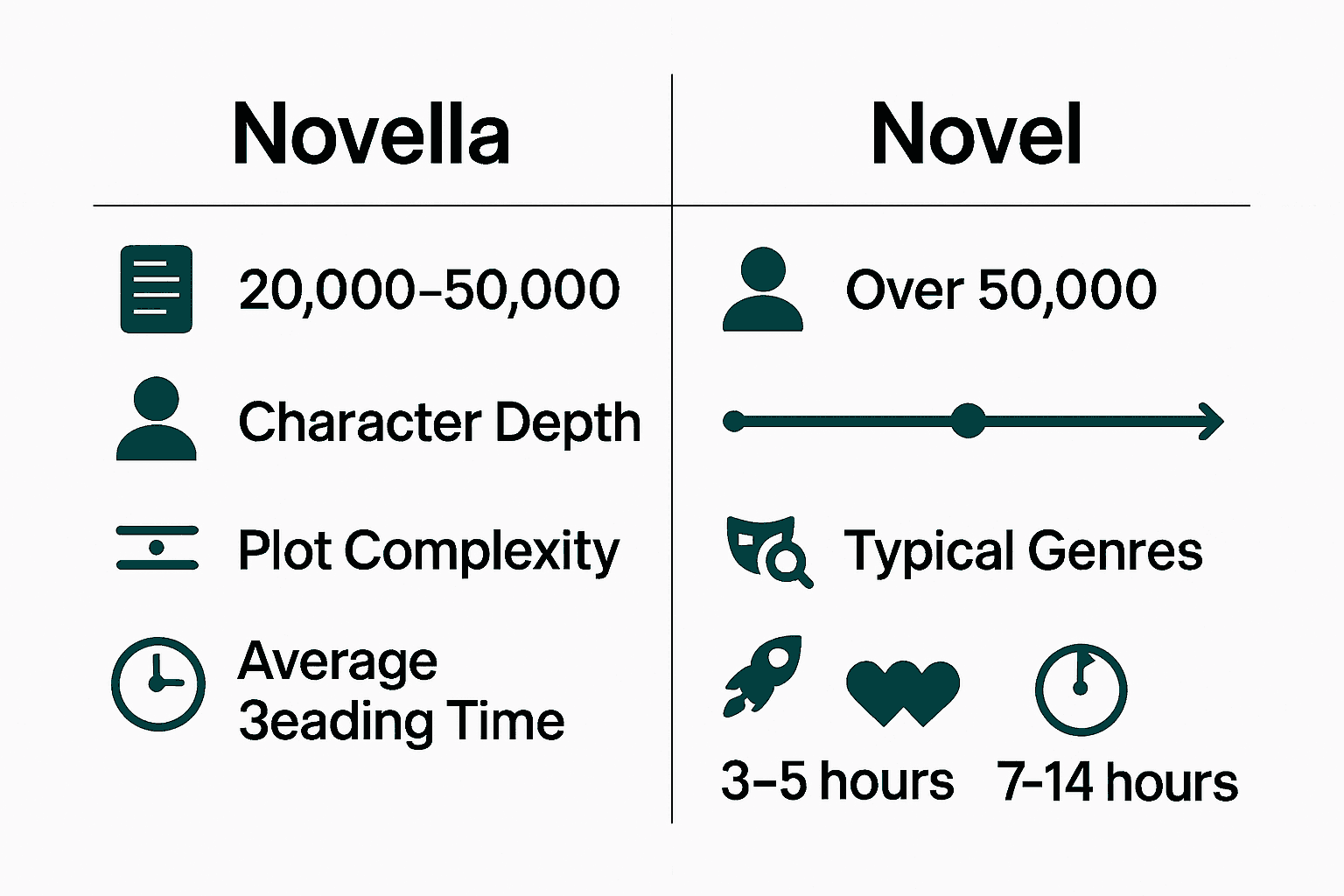
Reading Time Considerations
- Novellas: 1-3 hours reading time
- Novels: 6-12 hours reading time
- Short Stories: Under 1 hour
For readers interested in exploring different storytelling formats, Understanding the Benefits of Short Reads provides additional insights into why compact narratives can be just as compelling as their longer counterparts. The beauty of both formats lies in their ability to transport readers into distinct worlds, whether through a concentrated burst of storytelling or an expansive, immersive journey.
Choosing Between Novellas and Novels
Deciding between writing a novella or a novel requires careful consideration of your story’s core elements and narrative ambitions. According to aspiringwriteracademy.com, critical factors include the complexity of plot, number of characters, and depth of character development.
Key Decision Factors
- Plot complexity
- Character count
- Narrative depth
- Time investment
- Thematic exploration
Research from spines.com suggests that novellas are ideal for focused narratives centered on a single theme or event, while novels provide expansive terrain for exploring multiple storylines and intricate character arcs. Think of a novella as a precise, targeted storytelling approach versus a novel’s panoramic narrative landscape.
Selection Criteria
- Choose novella if:
- Story centers on single character/event
- Limited plot complexity
- Tight narrative focus desired
- Choose novel if:
- Multiple character perspectives
- Complex, interconnected plot
- Extensive world-building needed
For writers seeking additional guidance in selecting the right format, Best Short Books offers insights into crafting compelling narratives across different story lengths. The ultimate decision hinges on your story’s unique requirements and the emotional journey you want to create for your readers.
Discover the Perfect Fit for Your Reading Taste Between Novellas and Novels
If you have ever felt torn between quick, immersive stories and expansive narratives then this guide on “Novellas vs. Novels” clearly highlights the challenge many readers face. The key hurdle is finding a story with the right balance of length and complexity to match your time and mood without sacrificing depth or engagement. Whether you want a focused thriller or a layered plot with multiple characters the right format makes all the difference.
Explore our curated collection of psychological thriller short reads, murder mystery novellas, and detective short reads crafted to deliver precisely that sharp narrative punch or the immersive experience you crave.
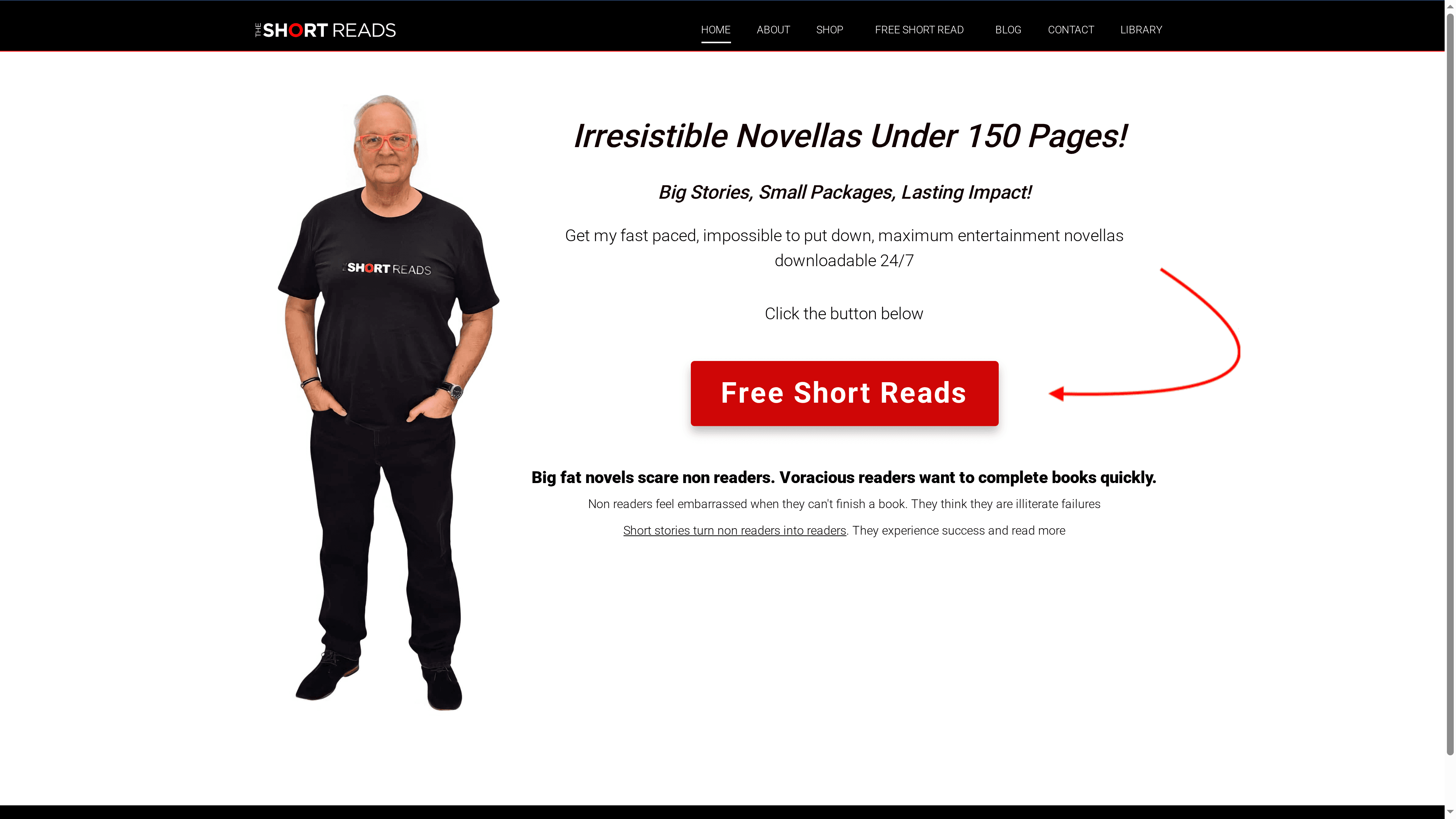
Dive into gripping stories that fit your lifestyle right now at The Short Reads. Take control of your reading journey with our handpicked selection and see why countless readers choose quality over quantity today! Don’t wait to experience storytelling that fits your pace and sparks your imagination. Start browsing now and find your next captivating read at online short reads.
Frequently Asked Questions
What is the primary difference between a novella and a novel?
The primary difference lies in length and narrative complexity: novellas are typically 20,000 to 40,000 words and focus on a single incident or theme, while novels exceed 50,000 words and support complex, multi-layered plots with multiple characters and subplots.
How long does it typically take to read a novella compared to a novel?
Novellas usually take 1-3 hours to read, whereas novels can require 6-12 hours, depending on their length and complexity.
What genres are best suited for novellas?
Novellas excel in genres that benefit from concise storytelling, such as romance, mystery, suspense, and psychological thrillers, focusing on a singular theme or character arc.
How do I decide whether to write a novella or a novel?
Consider factors such as plot complexity, character count, narrative depth, and the emotional journey you want to create. If your story centers on a single event or has limited complexity, a novella may be ideal. For more intricate narratives with multiple perspectives, a novel is the better choice.
Recommended
- Short Reads vs Full Novels: Complete Guide – TheShortReads.com
- Short Reads vs Novels: Complete Guide for Readers – TheShortReads.com
- What is Flash Fiction? Understanding This Unique Story Form – TheShortReads.com
- 7 Mystery Fiction Types for Learners and Busy Readers – TheShortReads.com
The Essential Guide to the Role of Novellas in Fiction

More than 60 percent of avid readers seek stories they can finish in just a few sittings, yet crave the depth often missing from short stories. Novellas answer this need by combining rich character development with a focused narrative that never drags. These compact works have carved out a special place in modern fiction, offering readers a satisfying blend of brevity and substance for those moments when time is short but substance still matters.
Table of Contents
- Defining Novellas In Modern Fiction
- Novella Types And Genre Variations
- Core Characteristics And Unique Appeal
- Impact On Readers And Literary Culture
- Comparing Novellas To Short Stories And Novels
Key Takeaways
| Point | Details |
|---|---|
| Definition of Novella | A novella is a narrative form bridging short stories and novels, typically ranging between 20,000 to 50,000 words. |
| Literary Flexibility | Novellas span multiple genres, allowing for complex themes without the extensive commitment of full-length novels. |
| Unique Appeal | They deliver complete narratives with intense character development and focused conflicts, resonating deeply with readers. |
| Cultural Impact | Novellas democratize storytelling, providing accessible reading experiences and encouraging innovative narrative structures. |
Defining Novellas in Modern Fiction
In the vast landscape of literary forms, the novella emerges as a unique narrative creature, bridging the gap between short stories and full-length novels. According to New World Encyclopedia, a novella is a prose fiction work that typically explores a single event or character’s critical turning point, originating from the Italian word meaning ‘new’.
The contemporary understanding of novellas centers on their distinctive length and narrative complexity. Wikipedia highlights that novellas possess fewer conflicts than novels but more intricate plotlines than short stories. This nuanced positioning allows writers to craft deeply intimate narratives without the extensive world-building required in longer novels.
Key characteristics of novellas include:
- Typically ranging between 20,000 to 50,000 words
- Focused on a single primary conflict or character arc
- More developed than short stories but more concentrated than full novels
- Often serving as powerful vehicles for intense, character-driven storytelling
For readers seeking compact yet profound reading experiences, short reads vs full novels guide offers additional insights into understanding these narrative forms. Novellas represent a compelling middle ground in fiction, offering depth without demanding the extensive time commitment of a traditional novel.
Novella Types and Genre Variations
Novellas represent a dynamic literary form that spans multiple genres, offering writers a unique canvas for storytelling. Wikipedia reveals that these compact narratives can effectively encompass diverse genres including science fiction, fantasy, horror, romance, and psychological fiction, each presenting distinctive opportunities for narrative exploration.
The genre flexibility of novellas allows writers to dive deep into complex themes without the extensive commitment required by full-length novels. New World Encyclopedia emphasizes that novellas excel at exploring nuanced narratives that might feel rushed in short stories or underdeveloped in traditional novels. This adaptability makes them perfect for experimental and focused storytelling.
Genre-specific novella characteristics include:
- Science Fiction Novellas: Often exploring high-concept ideas with intricate technological or philosophical themes
- Psychological Thrillers: Providing intense character studies within a concentrated narrative framework
- Historical Fiction: Offering detailed explorations of specific historical moments or personal experiences
- Romance: Crafting intimate character developments without extensive subplots
For readers interested in exploring different narrative lengths, our short reads vs full novels guide provides additional context about how different fiction formats can deliver compelling storytelling experiences. Novellas ultimately represent a powerful, genre-spanning form that bridges the gap between brevity and depth.

Core Characteristics and Unique Appeal
Wikipedia reveals that novellas occupy a distinctive literary space, characterized by their carefully crafted narrative structure and precise length. These compact narratives typically range between 20,000 and 50,000 words, offering readers an immersive experience that balances depth and concision. Unlike short stories, novellas provide ample room for nuanced character development and complex thematic exploration.
The unique appeal of novellas lies in their ability to deliver a complete narrative arc with remarkable intensity. New World Encyclopedia emphasizes that these works excel at focusing on a single pivotal event or character transformation, creating an intimate storytelling experience that resonates deeply with readers. This concentrated narrative approach allows writers to explore intricate emotional landscapes without the extensive world-building required in full-length novels.
Key characteristics that define novellas include:
- Concentrated narrative focus
- Limited but complex character development
- Typically exploring a single primary conflict
- More psychological depth than short stories
- Ability to maintain narrative tension throughout
For readers seeking rich storytelling in a compact format, short reads vs full novels guide offers additional insights into the unique reading experience novellas provide. These literary gems represent a perfect middle ground between brevity and narrative complexity, offering readers an immersive journey that can be completed in a single, engaging sitting.
Impact on Readers and Literary Culture
Wikipedia reveals that novellas have profoundly transformed literary culture by offering readers a unique storytelling experience that bridges the gap between short stories and full-length novels. These compact narratives provide an accessible entry point for readers who may feel intimidated by lengthy novels or find short stories too brief, creating a more inclusive reading landscape that caters to diverse literary preferences.
The cultural significance of novellas extends beyond reader accessibility. New World Encyclopedia emphasizes their crucial role in challenging traditional narrative structures and providing writers a flexible platform for exploring complex themes with remarkable depth and precision. By demanding concentrated storytelling, novellas have pushed literary boundaries, encouraging more experimental and focused narrative approaches.
Key impacts on literary culture include:
- Democratizing storytelling by offering more affordable and time-efficient reading experiences
- Providing platforms for emerging writers to showcase complex narratives
- Encouraging deeper reader engagement through concentrated storytelling
- Challenging traditional genre boundaries
- Facilitating cross-cultural literary exchanges
For readers seeking to explore the transformative power of compact narratives, our guide on understanding the benefits of short reads offers additional insights into how these literary forms are reshaping contemporary reading experiences. Novellas ultimately represent more than just a literary format—they are a dynamic cultural expression that continues to evolve and challenge our understanding of storytelling.
Comparing Novellas to Short Stories and Novels
Wikipedia illuminates the unique literary positioning of novellas, which occupy a distinctive space between short stories and full-length novels. These narrative forms differ significantly in length, complexity, and storytelling approach. While short stories typically range from 1,000 to 7,500 words and novels start around 50,000 words, novellas comfortably inhabit the 20,000 to 50,000-word range, offering a nuanced storytelling experience that balances depth and concision.
New World Encyclopedia emphasizes that novellas distinguish themselves through their concentrated narrative focus. Unlike short stories, which often capture a single moment or impression, and novels, which can explore multiple subplots and extensive character arcs, novellas provide a more focused exploration of a primary narrative thread. This allows for deeper character development and thematic complexity without the expansive world-building required in longer novels.
Key comparative characteristics include:
- Short Stories: Limited character development, single scene or moment
- Novellas: Focused narrative, moderate character depth, single primary conflict
- Novels: Multiple subplots, extensive character arcs, comprehensive world-building
For readers interested in exploring different narrative formats, our guide on understanding short story structure offers additional insights into the nuanced world of compact storytelling. Novellas ultimately represent a literary sweet spot—providing more narrative richness than short stories while maintaining a more concentrated and intense reading experience compared to traditional novels.
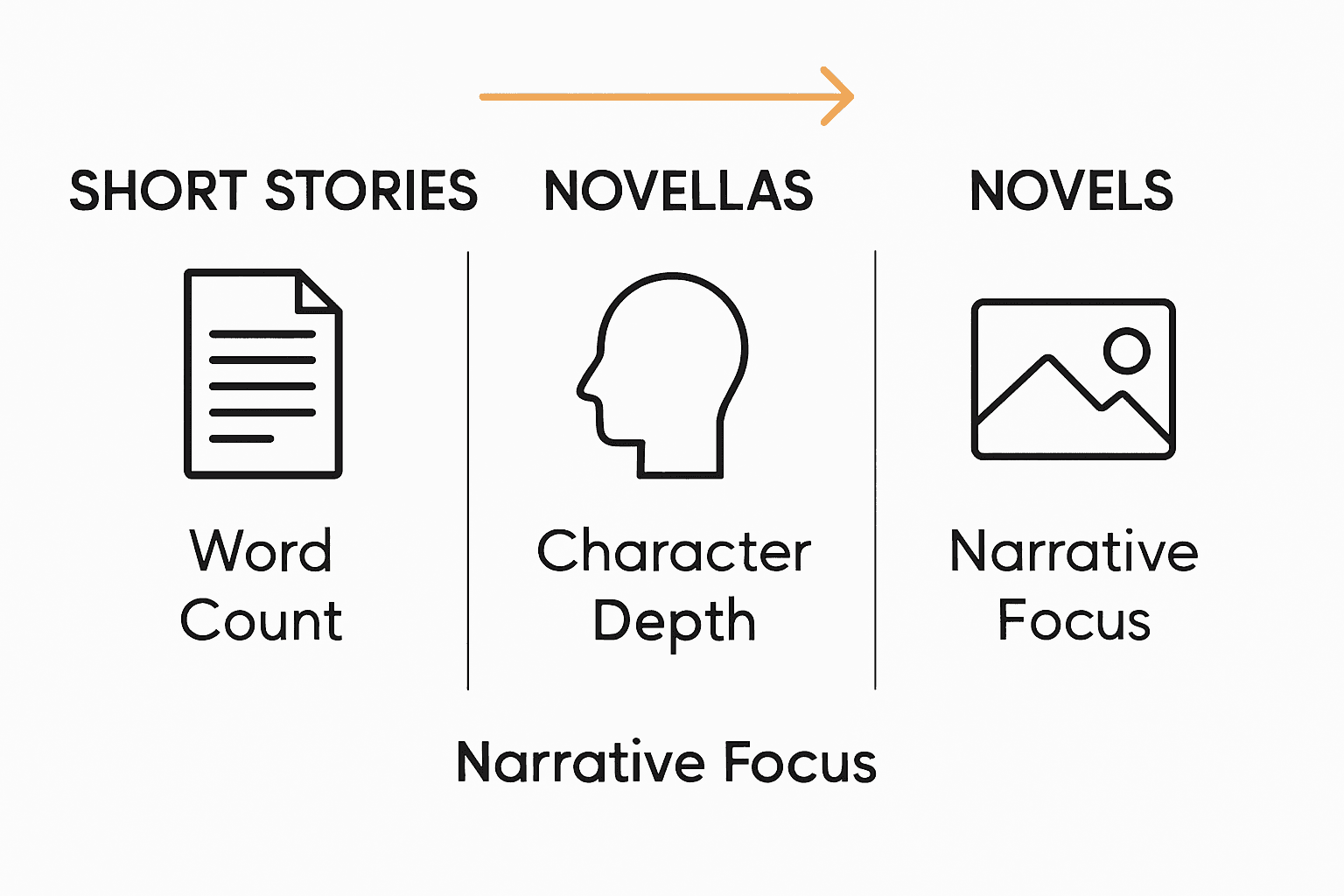
Discover the Power of Novellas with Compact Thrills and Deep Stories
Struggling to find rich, immersive stories that fit your busy schedule? This article shows how novellas deliver intense character-driven plots and focused narratives without the time commitment of a full novel. If you crave concise but impactful fiction, explore our collection of psychological thriller short reads and murder mystery novellas crafted to keep you hooked from start to finish.

Dive into stories that master the art of concentrated storytelling while offering the emotional depth the article highlights. Visit The Short Reads now and experience the unique balance between brevity and narrative power only novellas can provide. Don’t wait to enjoy fiction that fits perfectly into your lifestyle and satisfies your literary cravings.
Frequently Asked Questions
What is a novella?
A novella is a prose fiction work typically ranging between 20,000 to 50,000 words that focuses on a single primary conflict or character arc, offering a narrative that is more intricate than a short story but more concise than a full-length novel.
How do novellas differ from short stories?
Novellas differ from short stories primarily in length and narrative complexity. While short stories usually range from 1,000 to 7,500 words, novellas provide more space for character development and thematic exploration, typically focusing on a single narrative thread.
What genres can novellas encompass?
Novellas can span various genres, including science fiction, fantasy, horror, romance, and psychological fiction. This genre flexibility allows writers to explore complex themes and create rich narratives without the extensive commitment required by novels.
Why might a reader choose a novella over a full-length novel?
Readers might choose novellas for their compact and profound storytelling experience, which allows for an immersive plot without the lengthy time commitment of a full-length novel. They offer depth and narrative intensity in a shorter format, making them appealing for quick, yet impactful, reads.
Recommended
- Short Reads vs Novels: Complete Guide for Readers – TheShortReads.com
- Short Reads vs Full Novels: Complete Guide – TheShortReads.com
- How to Outline a Short Story in 5 Easy Steps – TheShortReads.com
- Short Mystery Writing Tips for Captivating Tales – TheShortReads.com
- Understanding Graphic Novels vs Traditional Novels – The Mansion Press
Short Reads vs Novellas: Everything You Need to Know

Most readers have felt the frustration of picking up a book that is either too brief or overwhelmingly long for their mood or schedule. Knowing whether you want a short read or a novella can make all the difference in enjoying your time with a story. Short reads usually clock in under 7,500 words and novellas range between 17,500 and 40,000 words. Understanding the real differences helps you select stories that match your interest, pace, and depth without second-guessing your choice.
Table of Contents
- Defining Short Reads And Novellas Clearly
- Key Differences In Length And Structure
- Popular Genres And Audience Preferences
- Benefits For Busy And Reluctant Readers
- Choosing Between Short Reads And Novellas
Key Takeaways
| Point | Details |
|---|---|
| Understanding Formats | Short reads are typically under 7,500 words, while novellas range from 17,500 to 40,000 words, allowing readers to choose based on their available time and engagement level. |
| Narrative Complexity | Novellas allow for deeper character development and complex themes compared to short reads, which focus on a single narrative arc. |
| Audience Preferences | Short reads appeal to busy readers seeking quick satisfaction, whereas novellas attract those who desire more intricate storytelling without committing to full novels. |
| Choosing the Right Format | Opt for short reads for immediate emotional impact and quick reads, while novellas are suited for stories requiring moderate depth and character exploration. |
Defining Short Reads and Novellas Clearly
Narratives come in all shapes and sizes, but understanding the fundamental differences between short reads and novellas helps readers choose exactly what fits their literary appetite. According to Wikipedia, a short story is “a piece of prose fiction that can typically be read in a single sitting and focuses on a self-contained incident or series of linked incidents, with the intent of evoking a single effect or mood.”
Novellas represent a fascinating middle ground in literary formats. Wikipedia defines them as “a narrative prose fiction whose length is shorter than most novels but longer than most short stories, typically ranging from 17,500 to 40,000 words.” This precise definition helps readers understand the structured landscape between brief stories and full-length novels.
Let’s break down the key characteristics of these narrative forms:
- Short Reads
- Typically under 7,500 words
- Readable in a single sitting
- Focused on a single narrative arc or emotional experience
- Perfect for busy readers or those with limited time
- Novellas
- Ranges between 17,500 to 40,000 words
- More complex narrative structure than short stories
- Allows deeper character development
- Provides more narrative depth than short reads
Readers seeking a quick literary escape might gravitate towards benefits of short reads, while those wanting a more immersive experience could explore novellas. Both formats offer unique storytelling opportunities that cater to different reading preferences and time constraints.
Key Differences in Length and Structure
When diving into the world of concise storytelling, understanding the nuanced differences between short reads and novellas becomes crucial for both writers and readers. International Association of Professional Writers and Editors provides clear parameters, noting that the Science Fiction and Fantasy Writers Association defines word count ranges that distinguish these formats: short stories extend up to 7,500 words, while novellas span between 17,500 and 40,000 words.
Beyond pure word count, these formats differ dramatically in narrative complexity and structural approach. New York Book Editors explain that novellas typically “concentrate on one event or character’s development arc, with a central theme or conflict” and notably lack the extensive subplots and detailed character development found in full-length novels.
Let’s explore the key structural differences:
Short Reads
- Ultra-compact narrative
- Single perspective or tight focus
- Minimal character background
- Typically resolves a single conflict
- Designed for quick, immediate emotional impact
Novellas
- More expansive narrative space
- Deeper character exploration
- Can develop more complex themes
- Often features a more intricate narrative arc
- Allows for more nuanced storytelling

Readers interested in understanding narrative techniques might want to check out our tutorial on short story structure, which provides deeper insights into these compelling storytelling formats.
Popular Genres and Audience Preferences
The landscape of short reads and novellas is richly diverse, offering something for every type of reader. New York Book Editors highlight that novellas are particularly popular in genres like science fiction, fantasy, and romance, appealing to readers who want compelling narratives that can be consumed in just one or two sittings.
International Center for Academic Research explains that novellas excel at providing an in-depth exploration of specific topics without demanding the time commitment of a full-length novel. This makes them perfect for readers who want a more immersive experience than a short story, but don’t have time for a sprawling novel.
Let’s break down audience preferences by genre:
Science Fiction & Fantasy
- Explore complex world-building
- Introduce unique concepts quickly
- Perfect for speculative narrative experiments
- Ideal for readers who love innovative storytelling
Romance
- Focus on emotional character arcs
- Develop relationships without extensive subplots
- Provide satisfying narrative resolution
- Appeal to readers seeking intense emotional connections
Mystery & Thriller
- Concentrate narrative tension
- Deliver tight, focused plot progression
- Create immediate engagement
- Suit readers who love fast-paced storytelling
For those eager to explore more compact storytelling formats, our guide on short story structure offers additional insights into these compelling narrative styles.
Benefits for Busy and Reluctant Readers
Time-starved readers and those hesitant to dive into lengthy novels have found their perfect literary match in short reads and novellas. New York Book Editors emphasize that novellas provide a more substantial narrative experience than short stories while remaining significantly faster to read than full-length novels, making them ideal for individuals with limited reading time.
International Center for Academic Research reveals an intriguing aspect of these compact narratives: their brevity forces writers to eliminate everything that doesn’t directly serve the central theme. This results in a laser-focused reading experience that captures and maintains reader engagement without overwhelming them with unnecessary details.
Key benefits for different reader types include:
For Busy Professionals
- Quick reading during commutes
- Complete stories in single sittings
- Intellectual stimulation without massive time investment
- Portable entertainment
For Reluctant Readers
- Less intimidating than lengthy novels
- Immediate narrative gratification
- Lower commitment threshold
- Builds reading confidence
For Multitaskers
- Fits into tight schedules
- Provides narrative satisfaction
- Can be read in short bursts
- Maintains reading momentum
Readers looking to explore compact storytelling can check out our guide on mystery fiction types for learners and busy readers, which offers additional insights into making reading more accessible and enjoyable.
Choosing Between Short Reads and Novellas
Navigating the literary landscape requires understanding the nuanced differences between short reads and novellas. New York Book Editors suggest that the primary consideration when selecting your narrative format is the inherent complexity of your story. Novellas offer a unique middle ground, providing more robust character development and plot intricacy than short stories while remaining more concentrated than full-length novels.
International Center for Academic Research recommends assessing your narrative’s core focus. If your story centers on a singular, compelling theme or conflict that demands more narrative depth than a short story but doesn’t require a novel’s expansive exploration, a novella might be your ideal storytelling vessel.
Key Decision Factors:
Choose a Short Read If:
- You have a single, powerful narrative moment
- Limited character background is needed
- Quick emotional impact is the primary goal
- Time constraints are significant
- Immediate storytelling resolution is preferred
Choose a Novella If:
- Your story needs moderate character development
- Complex themes require more space
- You want deeper narrative exploration
- The central conflict needs nuanced treatment
- Readers want more context than a short story
Readers seeking curated reading experiences can explore our best short books collection to discover compelling narratives that match their reading preferences.
Discover Your Perfect Story in Short Reads and Novellas
Choosing between short reads and novellas can feel overwhelming when you want a fulfilling story without investing too much time. This article showed how short reads deliver quick, powerful narratives while novellas provide richer character development and deeper themes. Whether you crave a fast emotional impact or a more immersive experience, finding the right format matters.
At The Short Reads, we understand these needs and offer a carefully curated collection of cozy mystery short reads, action thriller novellas, psychological thriller short reads, and more to match your mood and time availability. Our library is designed to keep you engaged without the overwhelm of a lengthy novel.
Elevate your reading journey today and explore stories crafted specifically for busy and thoughtful readers.

Ready to dive into stories that fit your life and interests perfectly Visit The Short Reads now and find your next great read from our mystery fiction short reads and murder mystery novellas collections Don’t wait to experience the joy of storytelling tailored to you
![]()
Frequently Asked Questions
What is the difference between short reads and novellas?
Short reads are typically under 7,500 words, focused on a single narrative arc, and designed to be read in one sitting. Novellas range from 17,500 to 40,000 words, allowing for more complex narrative structures and deeper character development.
How long does it take to read a novella compared to a short read?
Generally, short reads can be completed in a single sitting, often taking just an hour or less. Novellas, while still quicker than full-length novels, may take a couple of hours to read, depending on the length and the reader’s pace.
What genres are popular for novellas and short reads?
Both short reads and novellas are popular across various genres, but novellas are particularly favored in science fiction, fantasy, and romance. Short reads tend to be versatile and can encompass many different themes and styles.
Who benefits from reading short reads and novellas?
Time-starved readers, reluctant readers, and multitaskers benefit greatly from both formats. Short reads offer immediate emotional impacts, while novellas provide a more substantial narrative experience without the time investment required for full-length novels.
Recommended
- Understanding the Benefits of Short Reads – TheShortReads.com
- Best Short Books – TheShortReads.com
- What is Flash Fiction? Understanding This Unique Story Form – TheShortReads.com
Short Reads vs Full Novels: Complete Guide

Over 60 percent of readers admit they struggle to finish traditional novels in today’s busy world. With so many stories available in bite-sized formats, the lines between short reads and full novels can get confusing fast. Knowing exactly what sets these two forms apart helps you save time and ensures a satisfying reading experience, whether you want a quick adventure or a deep literary journey.
Table of Contents
- Short Reads vs Full Novels Defined
- Genres and Types: Mysteries, Thrillers, and More
- Key Benefits and Appeal for Modern Readers
- Misconceptions About Short and Long Fiction
- Choosing the Right Format for Your Lifestyle
Key Takeaways
| Point | Details |
|---|---|
| Short Reads | Ideal for quick consumption, short reads offer concise narratives focusing on single plots and emotional intensity. |
| Full Novels | Provide an immersive experience, allowing for complex character development and exploration of intricate themes. |
| Modern Appeal | Short reads cater to busy lifestyles by delivering impactful stories in less time, appealing to a diverse range of readers. |
| Misconceptions | Short stories are not lesser forms of narrative; they entail unique structures capable of profound thematic exploration. |
Short Reads vs Full Novels Defined
Understanding the fundamental differences between short reads and full novels is crucial for readers seeking the perfect literary experience. According to Eric Education Research, these two forms of storytelling have distinct characteristics that shape their narrative structure, complexity, and reader engagement.
A short read is a concise narrative typically ranging between 3,500-7,500 words, designed to be consumed in a single sitting. As research from RSIS International explains, short stories are prose narratives that focus on:
- A single plot or event
- A limited number of characters
- A unified, concentrated theme
- Creating a singular emotional effect or mood
In contrast, a full novel presents a more expansive narrative landscape. These longer works typically involve:
- Multiple connected sequences of events
- Complex character developments
- Intricate sub-plots
- Broader exploration of themes and societal issues
- Extended time frames and multiple settings
The primary distinction lies in depth and scope.
 Short reads offer quick, intense bursts of storytelling that can be rapidly consumed, perfect for busy readers or those seeking concentrated narrative experiences.
Short reads offer quick, intense bursts of storytelling that can be rapidly consumed, perfect for busy readers or those seeking concentrated narrative experiences.
![]() Full novels from TheShortReads.com provide more immersive, comprehensive storytelling that allows readers to deeply explore characters, environments, and intricate narrative arcs.
Full novels from TheShortReads.com provide more immersive, comprehensive storytelling that allows readers to deeply explore characters, environments, and intricate narrative arcs.
Genres and Types: Mysteries, Thrillers, and More
The world of short reads and novels is rich with diverse genres that cater to different reader preferences and storytelling styles. According to AS Authors, mystery and thriller genres offer a fascinating array of subgenres that capture readers’ imaginations with unique narrative approaches.
Mystery Genres encompass several compelling subgenres:
- Noir Fiction: Dark, atmospheric stories with morally complex characters
- Locked Room Mysteries: Seemingly impossible crime scenarios that challenge logical reasoning
- Cozy Mysteries: Gentle narratives featuring amateur sleuths in small communities
- Hard-Boiled Mysteries: Gritty urban settings with tough, realistic detective protagonists
As research from English Studies reveals, Thriller Genres offer equally diverse storytelling experiences:
- Psychological Thrillers: Deep explorations of characters’ mental landscapes
- Espionage Thrillers: High-stakes spy narratives with international intrigue
- Political Thrillers: Dramatic stories involving governmental conspiracies
- Legal Thrillers: Intense courtroom and legal system narratives
For readers seeking a comprehensive understanding of these intricate genres, Mystery Fiction Terminology Guide provides deeper insights into the nuanced world of mystery and thriller narratives. Each genre offers a unique lens through which complex human experiences are explored, making them perfect for readers who enjoy compact, intense storytelling experiences.
Key Benefits and Appeal for Modern Readers
In today’s fast-paced world, readers are increasingly seeking literary experiences that fit their dynamic lifestyles. According to research from RSIS International, short reads have emerged as the perfect solution for modern readers seeking meaningful narratives in compact formats.
Key Benefits of Short Reads:
- Time Efficiency: Complete stories in a single sitting
- Immediate Gratification: Quick narrative resolution
- Accessibility: Perfect for commuters and busy professionals
- Diverse Storytelling: Intense, focused narrative experiences
Research from Eric Education Files highlights additional advantages, noting that short novels provide significant benefits beyond entertainment. They offer:
- Vocabulary Development: Introduction of new words in context
- Sustained Narrative Engagement: Maintaining reader interest
- Motivational Reading Experience: Encouraging continued literary exploration
Understanding the Benefits of Short Reads reveals that these compact narratives are more than just quick reads. They represent a sophisticated literary form that caters to contemporary reading habits, offering rich storytelling experiences without demanding extensive time commitments. Modern readers can now enjoy complex narratives, character developments, and thematic explorations in formats that seamlessly integrate with their busy lifestyles.
Misconceptions About Short and Long Fiction
The literary world is rife with misunderstandings about the nature and value of short reads and full-length novels. According to Eric Education Research, one of the most persistent misconceptions is that short stories are simply condensed versions of novels.
Common Misconceptions About Short Fiction:
- Myth: Short stories lack complexity
- Reality: Concentrated narrative depth
- Myth: They are just incomplete novel drafts
- Reality: Distinct narrative art form with unique structure
Research from RSIS International challenges another widespread belief, revealing that short stories are not shallow or less meaningful simply because of their brevity. In fact, they are meticulously crafted to:
- Deliver profound themes in minimal space
- Create intense emotional experiences
- Provide complete narrative arcs
- Engage readers with precision and impact
What is Flash Fiction? demonstrates that these compact narratives are sophisticated literary forms, capable of conveying complex ideas and emotions with remarkable efficiency. Contrary to popular belief, the length of a story does not determine its depth, emotional resonance, or artistic merit. Short fiction demands a different kind of mastery from writers – the ability to distill entire worlds and experiences into a few powerful pages.
Choosing the Right Format for Your Lifestyle
Reading is a personal journey that should seamlessly integrate with your unique lifestyle and time constraints. According to Eric Education Files, choosing between short reads and full novels is about finding the perfect literary experience that matches your available time and reading preferences.
Lifestyle Reading Profiles:
- The Commuter Reader: Short stories during transit
- The Weekend Warrior: Full novels during leisure time
- The Busy Professional: Novellas between work commitments
- The Constant Learner: Mix of formats for diverse experiences
Research from RSIS International highlights that reading formats are not one-size-fits-all. Different formats offer unique advantages:
- Short Stories: Quick, impactful reading sessions
- Novels: Deep, immersive narrative experiences
- Novellas: Balanced storytelling length
Short Reads vs Novels Guide reveals that modern readers have unprecedented flexibility in crafting their reading experience. Whether you have 15 minutes or several hours, there’s a literary format designed to fit your schedule, mood, and intellectual curiosity. The key is understanding your personal reading rhythm and choosing formats that enhance, rather than interrupt, your daily life.
Discover Stories That Fit Your Life
Struggling to find the perfect read that matches your busy schedule and craving for intense, immersive stories Understand the challenge of balancing time with rich storytelling We know you want quick, meaningful narratives that still deliver complex characters and gripping plots Whether you prefer cozy mysteries or psychological thrillers the challenge of picking between short reads and full novels can feel overwhelming
Explore a world of short read books that capture every thrilling moment from action-packed novellas to intricate murder mysteries Our collection at TheShortReads.com offers a variety of formats and genres that fit your lifestyle and keep you hooked The article highlighted how short reads provide immediate gratification while still embracing depth – now you can experience that firsthand with expertly crafted stories designed for readers like you
Dive into categories such as psychological thriller short reads and mystery fiction short reads crafted to trigger emotions and deliver powerful narratives in a fraction of the time you thought possible

Don’t wait to transform your reading habit Find your next favorite short read today and enjoy the perfect story no matter how much time you have Visit TheShortReads.com now and start your literary adventure with a thrilling, concise, and rewarding experience
Frequently Asked Questions
What is a short read?
A short read is a concise narrative typically ranging between 3,500 to 7,500 words, designed to be consumed in a single sitting, focusing on a single plot or event with limited characters and a unified theme.
How do short stories differ from full novels?
Short stories are generally shorter, focusing on a single event or theme, while full novels offer a more expansive narrative with multiple sequences, complex character developments, and broader thematic explorations.
What are the benefits of reading short stories?
Short stories provide time efficiency, immediate gratification, and accessibility, making them ideal for busy readers. They also help in vocabulary development and sustain narrative engagement.
Are short reads as valuable as full-length novels?
Yes, short reads are a distinct narrative art form that can deliver profound themes and intense emotional experiences despite their brevity. They are meticulously crafted to engage readers deeply in a compact format.
Recommended
- Short Reads vs Novels: Complete Guide for Readers – TheShortReads.com
- Understanding the Benefits of Short Reads – TheShortReads.com
- Best Short Books – TheShortReads.com
- What is Flash Fiction? Understanding This Unique Story Form – TheShortReads.com
Short Reads vs Novels: Complete Guide for Readers

Over 60 percent of readers now turn to shorter books or bite-sized stories due to busy schedules. The choice between a quick short read and a sweeping novel can shape the way you enjoy stories, especially if you crave meaningful narratives but have limited time. Whether you love fast-paced mysteries or long, intricate tales, recognizing the difference between these formats helps you match your reading with your lifestyle.
Table of Contents
- Defining Short Reads And Novels
- Key Genres: Cozy Mysteries And Thrillers
- Understanding Reader Preferences And Needs
- Benefits And Drawbacks Of Short Reads
- Comparing Reading Experience And Accessibility
- Short Reads Vs Novels: Choosing What Fits
Key Takeaways
| Point | Details |
|---|---|
| Short Reads vs Novels | Short reads offer quick, concentrated storytelling, usually under 15,000 words, while novels provide complex narratives over 50,000 words. |
| Genre Preferences | Cozy mysteries and psychological thrillers are popular short read genres, appealing to readers through engaging puzzles and intense character exploration. |
| Reader Needs | Time-constrained readers favor short reads for their ease of consumption in brief periods, making them ideal for busy lifestyles. |
| Choosing Formats | Select novels for immersive storytelling and deep character development, while short reads are suitable for quick resolutions and diverse experiences. |
Defining Short Reads and Novels
Reading formats are as diverse as the stories they contain, and understanding the difference between short reads and novels can transform your reading experience. According to Wikipedia, a novella represents a unique narrative length situated between traditional short stories and full novels, typically ranging from 17,500 to 40,000 words.
Novels, by contrast, are more expansive narrative forms. ijels defines them as “fictitious prose narratives of considerable length” that explore complex characters and intricate plot structures. While novels offer deep narrative immersion, short reads provide concentrated storytelling experiences perfect for readers with limited time or those seeking quick, engaging narratives.
The key distinctions between short reads and novels can be summarized as:
- Word Count: Short reads typically range from 1,000 to 15,000 words, while novels exceed 50,000 words
- Narrative Complexity: Short reads focus on singular plot points or character moments
- Reading Time: Short reads can be completed in one sitting (30-90 minutes)
- Depth of Exploration: Novels offer more comprehensive character development and intricate storylines
For readers seeking quick yet compelling stories, Understanding the Benefits of Short Reads provides additional insights into why these concise narratives are gaining popularity across diverse reading communities.
Key Genres: Cozy Mysteries and Thrillers
Within the landscape of short reads, two genres have captured readers’ imaginations: cozy mysteries and psychological thrillers. Wikipedia defines cozy mysteries as a unique sub-genre of crime fiction where the action happens subtly, with amateur sleuths solving crimes in intimate, close-knit communities.
Psychological thrillers, in contrast, dive deep into the complex mental landscapes of characters, exploring psychological tensions and intricate emotional dynamics. These narratives often feature protagonists navigating intense personal challenges, moral dilemmas, and unexpected psychological twists that keep readers on the edge of their seats.
Key characteristics of these compelling genres include:
- Cozy Mysteries:
- Minimal graphic violence
- Amateur detective protagonist
- Small-town or close community setting
- Focus on puzzle-solving and interpersonal dynamics
- Psychological Thrillers:
- Intense psychological exploration
- Complex character motivations
- Unexpected narrative twists
- Emphasis on mental and emotional suspense
Readers seeking deeper insights into these fascinating genres can explore our Themes in Psychological Thrillers guide, which offers a comprehensive exploration of the intricate storytelling techniques that make these short reads so captivating.
Understanding Reader Preferences and Needs
Reading preferences are deeply personal, shaped by individual lifestyles, time constraints, and narrative appetites. Women.com reveals that certain readers gravitate towards cozy mysteries precisely because they offer engaging puzzles without graphic violence, appealing to those who prefer intellectual stimulation over sensationalism.
Modern readers face unique challenges in consuming literature.
 Busy professionals, parents, and individuals with limited leisure time increasingly seek narrative experiences that can be enjoyed in shorter formats. Short reads have emerged as a perfect solution, offering complete storytelling experiences that can be consumed during commutes, lunch breaks, or brief moments of personal downtime.
Busy professionals, parents, and individuals with limited leisure time increasingly seek narrative experiences that can be enjoyed in shorter formats. Short reads have emerged as a perfect solution, offering complete storytelling experiences that can be consumed during commutes, lunch breaks, or brief moments of personal downtime.
Reader preferences can be categorized into several key motivational groups:
- Time-Constrained Readers:
- Prefer stories under 100 pages
- Want complete narrative arcs
- Seek high-impact storytelling
- Value efficient reading experiences
- Genre-Specific Enthusiasts:
- Deep interest in specific narrative styles
- Prefer targeted, concentrated storytelling
- Enjoy exploring niche narrative techniques
- Value authenticity over length
For readers wanting to explore how their reading preferences align with different short read genres, our Cozy Mystery Fiction resource provides nuanced insights into these captivating narrative experiences.
Benefits and Drawbacks of Short Reads
Wikipedia highlights the emerging trend of microblogging novels, which represent a revolutionary approach to storytelling that caters to modern readers’ shrinking attention spans and digital consumption habits. These compact narrative forms offer unprecedented accessibility, allowing readers to engage with stories in bite-sized, convenient formats that seamlessly integrate into busy lifestyles.
Short reads present a nuanced reading experience with distinct advantages and limitations. Unlike traditional novels, they provide immediate narrative gratification, enabling readers to complete entire stories during brief moments of downtime. Wikipedia notes that short story cycles can create enhanced reading experiences by offering depth and variety within more condensed formats, presenting readers with rich, interconnected narrative landscapes.
The key benefits and potential drawbacks of short reads include:
Benefits:
- Quick consumption
- Perfect for limited time windows
- Lower commitment
- Diverse narrative exploration
- Ideal for digital reading platforms
Drawbacks:
- Limited character development
- Less complex plot structures
- Reduced narrative depth
- Potentially unsatisfying for readers seeking immersive experiences
- Can feel incomplete compared to full-length novels
Readers curious about exploring these compact narrative forms can dive deeper with our What is Flash Fiction? resource, which offers comprehensive insights into these innovative storytelling techniques.
Comparing Reading Experience and Accessibility
Wikipedia reveals that novellas represent a fascinating middle ground in literary consumption, offering readers a uniquely balanced narrative experience. These intermediate-length works provide more narrative depth than short stories while maintaining a more digestible format compared to full-length novels, making them an ideal option for readers seeking substantial yet time-efficient storytelling.
The accessibility of different reading formats dramatically impacts how readers engage with literature. Modern reading experiences are increasingly influenced by technological platforms, personal time constraints, and individual cognitive preferences. Short reads have emerged as a powerful solution for readers who want rich narrative experiences without the significant time investment required by traditional novels.
Key comparative aspects of reading experiences include:
Reading Format Comparison:
- Novels:
- Extensive character development
- Complex, multi-layered plots
- Significant time commitment
- Deep narrative immersion
- Short Reads:
- Concentrated storytelling
- Quick narrative resolution
- Ideal for fragmented attention spans
- Flexible consumption
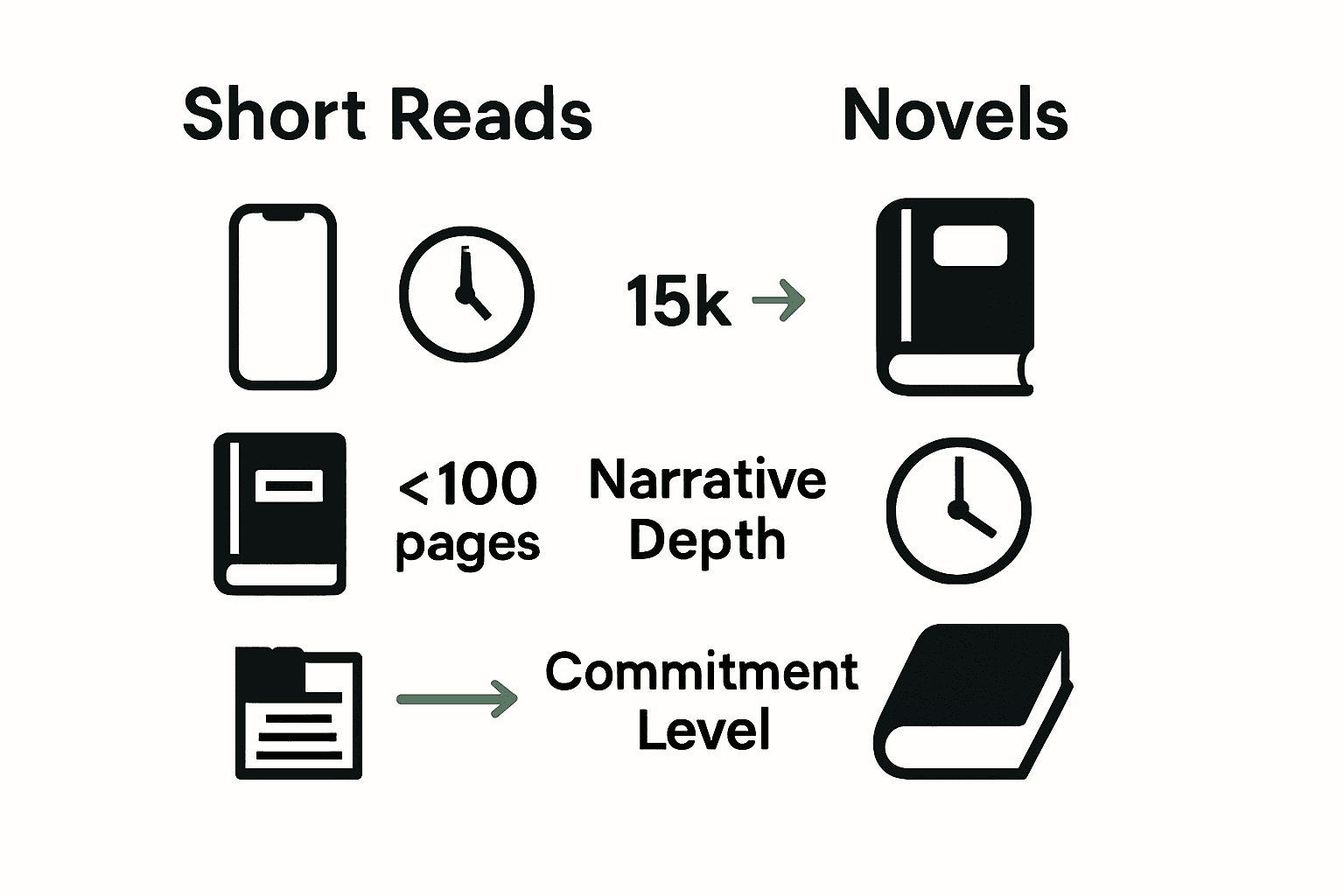
Wikipedia highlights contes as another fascinating narrative form, characterized by wit and fantasy, offering engaging stories that bridge the gap between traditional storytelling formats. These compact narratives demonstrate how literary experiences can be both rich and concise.
Readers interested in exploring the nuanced world of compact narratives can find deeper insights in our Understanding Short Story Structure guide, which provides a comprehensive exploration of these innovative storytelling approaches.
Short Reads vs Novels: Choosing What Fits
Wikipedia underscores that choosing between novellas and novels is ultimately a personal decision influenced by individual reading preferences, time availability, and narrative expectations. The selection process involves carefully weighing the depth of narrative immersion against the practical constraints of modern reading habits.
Readers must consider multiple factors when selecting their ideal reading format. Short reads offer immediate narrative satisfaction, while novels provide more comprehensive storytelling experiences. Wikipedia highlights that short story cycles present an innovative compromise, offering readers diverse narratives within a single collection and allowing for flexible, bite-sized literary exploration.
Key decision-making criteria include:
Choosing Your Ideal Reading Format:
- Choose Novels When You Want:
- Deep character development
- Complex, multi-layered plotlines
- Immersive long-form storytelling
- Extended narrative exploration
- Choose Short Reads When You Prefer:
- Quick narrative resolution
- Limited time commitment
- Diverse story experiences
- Flexible reading schedules
For readers seeking curated recommendations that match their reading preferences, our Best Short Books collection offers a carefully selected range of compact narratives to suit various tastes and reading styles.
Discover the Perfect Story Length for Your Lifestyle
Feeling torn between diving into a sprawling novel or savoring a quick, impactful story Often the challenge is finding narratives that fit your busy schedule yet still captivate your imagination. As highlighted in the article, short reads offer concentrated storytelling that fits into limited free time while novels provide deeper character journeys. If you crave the intensity of mysteries and thrillers but have little time to spare, exploring genres like cozy mysteries or psychological thrillers in short read form can be the perfect solution.

Unlock a world tailored for readers like you at The Short Reads. Whether you prefer cozy mystery short reads or thrilling novellas, our collection helps you stay immersed in gripping narratives without the long commitment. Act now to enjoy rich stories designed for efficient reading and personal enjoyment. Start your journey with carefully selected short reads today at The Short Reads and explore our curated mystery fiction short reads to match your reading preferences instantly.
Frequently Asked Questions
What is the main difference between short reads and novels?
Short reads typically range from 1,000 to 15,000 words, offering concentrated storytelling focused on singular plot points or character moments, while novels exceed 50,000 words and provide more extensive character development and intricate plots.
Why are short reads becoming popular among readers?
Short reads fit into busy lifestyles by offering complete stories that can be enjoyed in brief moments of free time, making them ideal for readers who face time constraints.
What genres are commonly found in short reads?
Common genres in short reads include cozy mysteries, which feature amateur sleuths solving crimes in small communities, and psychological thrillers that explore complex character motivations and intense emotional dynamics.
What are the advantages and disadvantages of reading short reads?
The advantages of short reads include quick consumption and lower commitment, ideal for fragmented attention spans. However, they may have limited character development and less complex plot structures compared to full-length novels.
Recommended
- Understanding the Benefits of Short Reads – TheShortReads.com
- Best Short Books – TheShortReads.com
- What is Flash Fiction? Understanding This Unique Story Form – TheShortReads.com
7 Smart Ways to Discover Mystery Fiction for Men

Over 60 percent of busy readers say they are drawn to stories that keep them hooked without eating up their entire weekend. Mystery fiction stands out because it offers suspenseful escapes in every format, from quick novellas to intricate detective sagas. Whether you want a fast-paced adventure or an immersive puzzle to solve, there is a perfect mystery waiting for you. Discover practical ways to enjoy gripping mysteries that fit your lifestyle and reading taste.
Table of Contents
- 1. Try Short Mystery Novellas For Quick Reads
- 2. Explore Genres: Action, Cozy, And Detective Stories
- 3. Use Online Platforms For Easy Access
- 4. Pick Books With Strong Male Leads
- 5. Join Book Clubs For Shared Experiences
- 6. Choose Books With Simple, Fast-Paced Plots
- 7. Seek Recommendations From Mystery Lovers
Quick Summary
| Takeaway | Explanation |
|---|---|
| 1. Choose Short Mysteries for Quick Reads | Short novellas under 300 pages can be read in one weekend, offering thrilling entertainment in less time. |
| 2. Explore Different Mystery Subgenres | Discover variations like cozy, action, and detective stories to match your reading preferences and interests. |
| 3. Use Online Resources for Easy Access | Platforms like OverDrive and Project Gutenberg allow borrowing or accessing a wide variety of mystery novels digitally. |
| 4. Join Book Clubs for Enhanced Experiences | Participate in book clubs to share insights and discover new authors, enriching your mystery reading journey. |
| 5. Seek Personalized Recommendations | Engage with fellow readers online or in person for tailored mystery book suggestions based on specific interests. |
1. Try Short Mystery Novellas for Quick Reads
Want to dive into mystery fiction without committing weeks to a massive novel? Short mystery novellas are your perfect solution. These compact stories pack intense narratives and gripping plots into manageable page counts, making them ideal for busy readers seeking thrilling entertainment.
According to Bustle, there are excellent mystery novels under 300 pages that can be devoured in a single weekend. Books like “The Other Side of Everything” by Lauren Doyle Owens and “The Chalk Man” by C.J. Tudor demonstrate how short novels can deliver complex storytelling without demanding excessive time.
Why choose short mystery novellas? They offer several compelling advantages:
- Time Efficiency: Read a complete story in just a few hours
- Intense Storytelling: Compact narratives with concentrated suspense
- Perfect for Beginners: Less intimidating entry point into mystery fiction
- Weekend Reading: Finish an entire thrilling narrative in one sitting
To get started, look for novellas around 200 to 300 pages with strong narrative hooks. Check online recommendation lists, bookstore mystery sections, or top picks from TheShortReads.com for curated suggestions that match your interests.
Pro tip: Start with award-winning or critically acclaimed shorter mystery novels to ensure high quality storytelling. Your weekend reading just got a lot more exciting.
2. Explore Genres: Action, Cozy, and Detective Stories
Mystery fiction is not a one-size-fits-all genre. Different subgenres offer unique reading experiences tailored to your specific interests and preferences. From high-octane action stories to charming small-town mysteries, understanding these categories can help you find exactly the reading adventure you crave.
According to Wikipedia, detective fiction encompasses a rich landscape of narrative styles and storytelling approaches. This genre offers readers multiple entry points into mysterious worlds with varying levels of complexity and excitement.
Subgenres to Explore:
- Cozy Mysteries: Gentle, low-violence stories typically set in small towns with amateur sleuths. As Wikipedia explains, these mysteries focus more on puzzle solving than graphic details.
- Action Mysteries: Fast paced narratives with high stakes and intense plot developments
- Detective Stories: Traditional narratives following professional or amateur investigators solving complex cases
To find your perfect mystery subgenre, experiment with different styles. Visit local bookstores, browse mystery fiction types for learners, and read sample chapters. Pay attention to the narrative style, pacing, and character dynamics that most appeal to you.
Pro tip: Start with shorter novels in each subgenre to quickly determine your preferred mystery style without investing too much time. Your perfect mystery adventure awaits.
3. Use Online Platforms for Easy Access
Modern technology has transformed how we discover and consume mystery fiction. Online platforms provide unprecedented access to thousands of mystery novels without leaving your home, making reading more convenient than ever before.
OverDrive offers an incredible solution for readers by partnering with libraries worldwide. This digital platform allows you to borrow ebooks and audiobooks through your local library membership, giving you instant access to a vast selection of mystery novels right from your digital device.
Digital Reading Resources:
- Project Gutenberg: Free digital library with classic mystery works
- OverDrive: Library partnership platform for digital book borrowing
- Kindle Unlimited: Subscription service with extensive mystery collections
- Local Library Digital Platforms: Free book borrowing through online systems
Project Gutenberg provides an exceptional resource for readers interested in classic mystery fiction. Their collection includes complete works by legendary authors like Arthur Conan Doyle, offering free digital downloads of entire Sherlock Holmes series and other timeless mystery novels.
To get started, download these apps on your smartphone or tablet. Create accounts with your local library credentials or explore free platforms. Pro tip: Many libraries offer digital memberships that provide free access to extensive mystery fiction collections.
4. Pick Books with Strong Male Leads
If you are looking to dive into mystery fiction that resonates with male readers, focusing on books with compelling male protagonists can transform your reading experience. Strong male leads offer unique perspectives and engaging narratives that capture complex character dynamics.
Take the Nameless Detective series by Bill Pronzini, which Wikipedia highlights as a prime example of a gripping male investigative narrative. Set in San Francisco, this long running series showcases a private investigator navigating intricate mystery landscapes with depth and authenticity.
What Makes a Strong Male Lead:
- Complex Psychological Depth: Characters with nuanced inner worlds
- Professional Expertise: Protagonists skilled in investigation or related fields
- Moral Complexity: Characters who wrestle with ethical challenges
- Personal Growth: Leads who evolve through their investigative experiences
Contemporary mysteries like Richard Osman’s “The Man Who Died Twice”) demonstrate how modern male protagonists can be multidimensional. The novel features a former MI6 agent entangled in an intricate case involving stolen diamonds and international criminal networks, showcasing intelligence and strategic thinking.
To find your ideal mystery novel, explore book reviews, ask for recommendations at local bookstores, and sample different series. Focus on protagonists that intrigue you beyond surface level action.
5. Join Book Clubs for Shared Experiences
Book clubs offer more than just reading recommendations. They provide a dynamic social environment where mystery fiction enthusiasts can dive deep into complex narratives, share insights, and expand their literary horizons.
Benefits of Mystery Fiction Book Clubs:
- Discover New Authors: Members introduce books you might never find alone
- Deeper Understanding: Group discussions reveal hidden plot nuances
- Social Connection: Meet like-minded mystery fiction enthusiasts
- Accountability: Regular meetups keep you consistently reading
Whether online or in person, book clubs create opportunities to explore mystery fiction from multiple perspectives. You will encounter diverse interpretations of storylines, character motivations, and narrative techniques that enhance your reading experience.
To get started, explore local library book clubs, online reading platforms like Goodreads, or community centers that host genre specific groups. Check out our shop for potential mystery fiction recommendations you can suggest to your book club.
Pro tip: Look for book clubs specifically focused on mystery or thriller genres to ensure more targeted and engaging discussions. Your next great reading adventure might just begin with a group conversation.
6. Choose Books with Simple, Fast-Paced Plots
Not all mystery readers want complex literary puzzles. For those seeking quick entertainment, fast-paced plots with straightforward narratives can provide an exciting reading experience without demanding excessive mental energy.
Wikipedia highlights Rex Stout’s ‘Trouble in Triplicate’ as a prime example of concise storytelling. This collection of Nero Wolfe novellas demonstrates how compelling mysteries can unfold rapidly, keeping readers engaged through streamlined narratives.
Characteristics of Fast-Paced Mystery Novels:
- Clear Story Progression: Linear plots with minimal digressions
- Quick Character Development: Immediate understanding of key personalities
- Minimal Backstory: Focus on present action and immediate conflict
- Rapid Plot Resolution: Mysteries solved within compact narratives
Modern readers appreciate stories that respect their time. Short reads from our recommended list offer perfect alternatives for busy individuals wanting engaging mysteries without lengthy commitments.
Pro tip: Look for novellas or short mystery collections that promise direct storytelling. Authors like Rex Stout excel at creating intricate yet accessible stories that unfold quickly and maintain high entertainment value.
7. Seek Recommendations from Mystery Lovers
Some of the best mystery fiction discoveries happen through conversations with passionate readers who live and breathe the genre. Fellow enthusiasts can offer personalized recommendations that algorithms and generic lists simply cannot match.
LibraryThing hosts incredible online communities like the Mystery Lovers group where dedicated fans share their most compelling reads. These platforms provide interactive spaces where you can dive deep into nuanced book discussions and uncover hidden literary gems.
Ways to Connect with Mystery Fiction Enthusiasts:
- Online Reading Communities: LibraryThing, Goodreads discussion groups
- Local Library Book Clubs: In person mystery fiction meetups
- Reddit Mystery Fiction Subreddits: Passionate reader discussions
- Social Media Mystery Reader Groups: Facebook and Twitter communities
For more curated suggestions, explore mystery fiction short stories that can quickly introduce you to new authors and styles. Many mystery lovers are eager to share their favorite reads and can help you navigate the vast world of detective and thriller narratives.
Pro tip: Always ask specific questions about plot styles, pacing, and character development when seeking recommendations. The more details you provide about your reading preferences, the more targeted the suggestions will be.
This table summarizes key strategies and benefits of engaging with mystery fiction through various formats and methods discussed in the article.
| Topic | Description | Benefits |
|---|---|---|
| Short Mystery Novellas | Compact stories with intense narratives; examples include “The Other Side of Everything” and “The Chalk Man”. | Quick reads, efficient storytelling, ideal for busy readers. |
| Explore Genres | Includes cozy, action, and detective stories; each offers unique reading experiences. | Tailored reading adventures, exposure to various storytelling styles. |
| Online Platforms | Access thousands of mystery novels via digital resources like OverDrive, Project Gutenberg, and Kindle Unlimited. | Convenient access, vast selection, borrow books digitally. |
| Strong Male Leads | Focus on books with compelling male protagonists, such as the “Nameless Detective” series. | Engaging narratives, complex characters, unique perspectives. |
| Book Clubs | Join groups for shared reading experiences and discussions. | Discover new authors, gain deeper understanding, social connection. |
| Fast-Paced Plots | Choose books with straightforward narratives; examples like Rex Stout’s “Trouble in Triplicate”. | Quick entertainment, minimal mental energy required. |
| Recommendations | Connect with mystery fiction enthusiasts for personalized suggestions. | Discover hidden gems, targeted reading based on preferences. |
Discover Your Perfect Mystery Read Today
If you are looking to overcome the challenge of finding engaging mystery fiction tailored just for men you are not alone. Many readers struggle with picking the right subgenre or finding books with strong male leads that fit their busy lifestyles. This article highlighted key goals like choosing short mystery novellas for quick reads exploring cozy or action-packed styles and engaging with communities for personalized recommendations. At TheShortReads.com we understand how important it is to connect you with fast paced mysteries or thoughtful detective stories that fit your unique taste and time constraints.
Explore our collection of mystery fiction short reads where you will find handpicked cozy mysteries and action thriller novellas designed to deliver suspense and satisfaction in a minimum amount of time. Whether you want to dive into psychological thrillers or gripping murder mystery novellas find exactly what you need to jumpstart your next reading adventure. Join fellow fans who get the perfect blend of storytelling and pacing without the wait.
Ready to uncover your next favorite mystery? Start browsing now and take advantage of expertly curated short reads that respect your time and excite your imagination.

Unlock thrilling mysteries crafted for busy readers. Visit TheShortReads.com and choose your next captivating read today.
Frequently Asked Questions
What are the best ways to discover short mystery novellas for men?
Short mystery novellas are great for busy readers looking for quick, engaging stories. Look for novellas around 200 to 300 pages, especially from award-winning authors, and consider checking online recommendations or curated lists for tailored options.
How do I explore different subgenres of mystery fiction effectively?
To explore mystery fiction subgenres, read sample chapters from action mysteries, cozy mysteries, and detective stories. Experiment with different styles to see which ones resonate with you, and start with shorter novels to gauge your interest without a long-term commitment.
What are the benefits of joining a mystery fiction book club for men?
Joining a mystery fiction book club allows you to deepen your understanding of stories and characters while connecting with fellow enthusiasts. To get started, seek out local meets or online groups focused on mystery genres to enhance your reading experience and discover new titles.
How can I find recommendations from other mystery fiction lovers?
Connect with other mystery fiction enthusiasts through online reading communities, social media groups, or local library events. Engage in discussions and ask specific questions about mystery novels to receive tailored recommendations that match your interests.
What should I consider when choosing books with strong male leads?
When selecting mystery books with strong male leads, focus on characters with complex psychological depth and relatable moral dilemmas. Look for novels that showcase character development and situational challenges, which will enhance your reading experience.
How can I locate fast-paced mystery novels?
To find fast-paced mystery novels, look for books that feature concise storytelling and linear plots. Seek out novellas or collections that promise quick reads, ensuring you can enjoy engaging narratives without lengthy commitments.
Recommended
- Mystery Fiction – TheShortReads.com
- 6 Must-Know Mystery Short Stories Examples for Everyone – TheShortReads.com
- Understanding Mystery Fiction Terminology Explained – TheShortReads.com
- 7 Mystery Fiction Types for Learners and Busy Readers – TheShortReads.com
